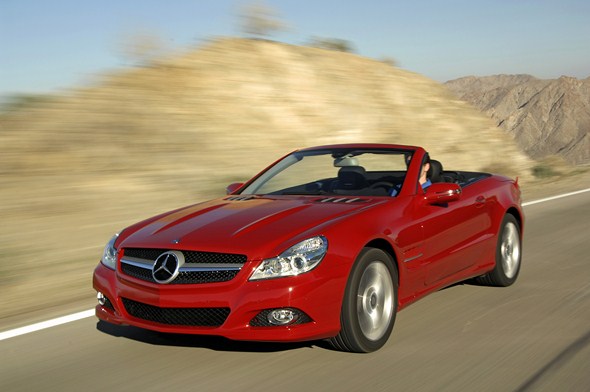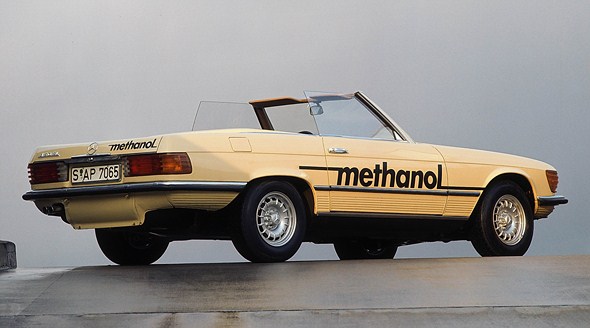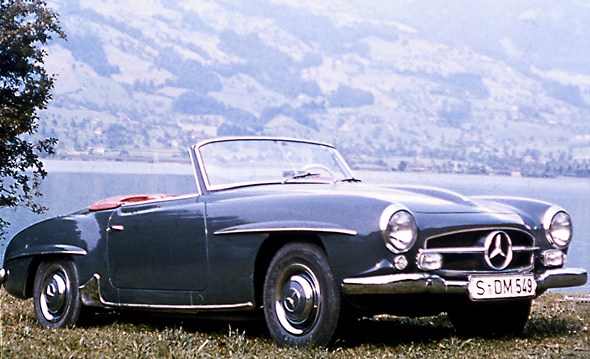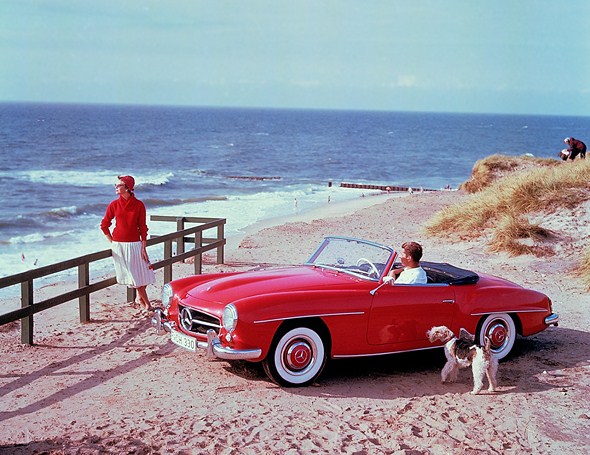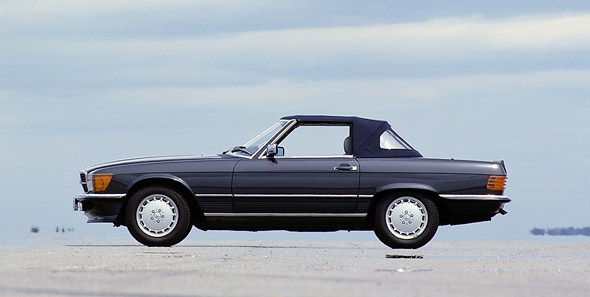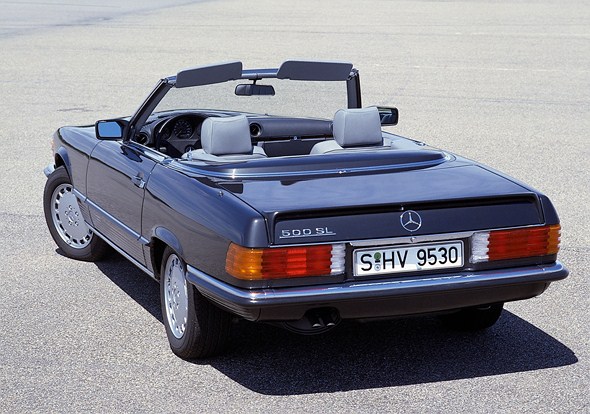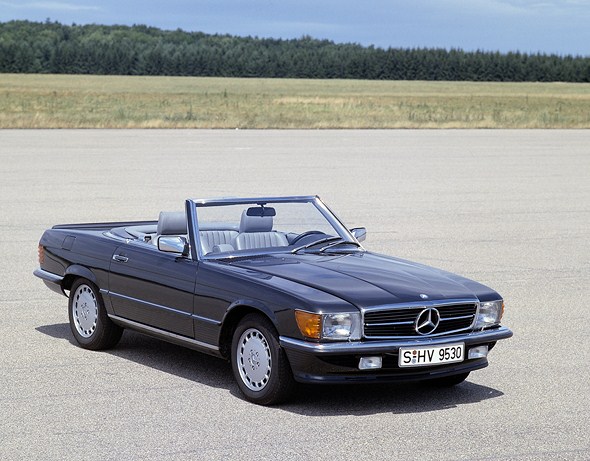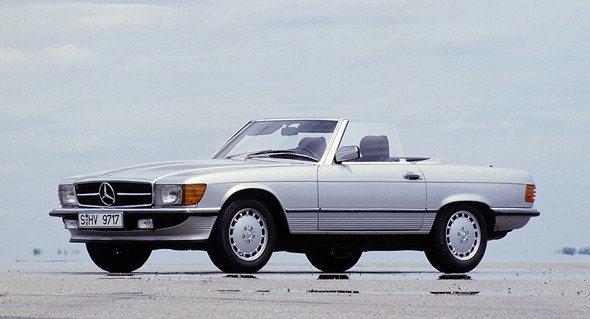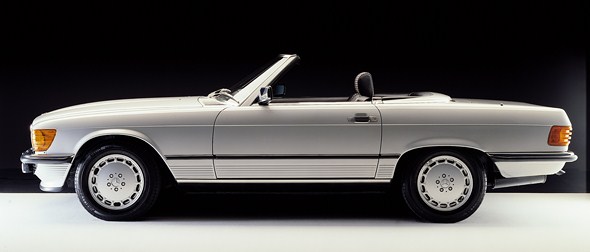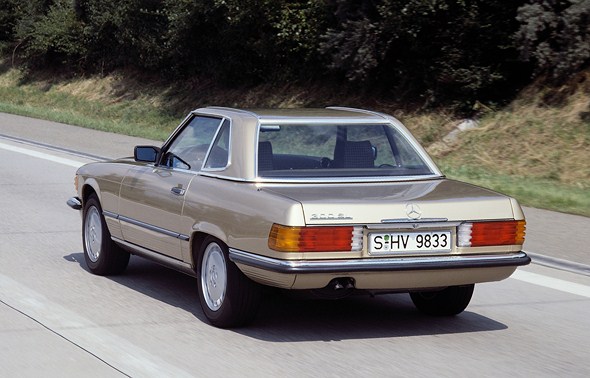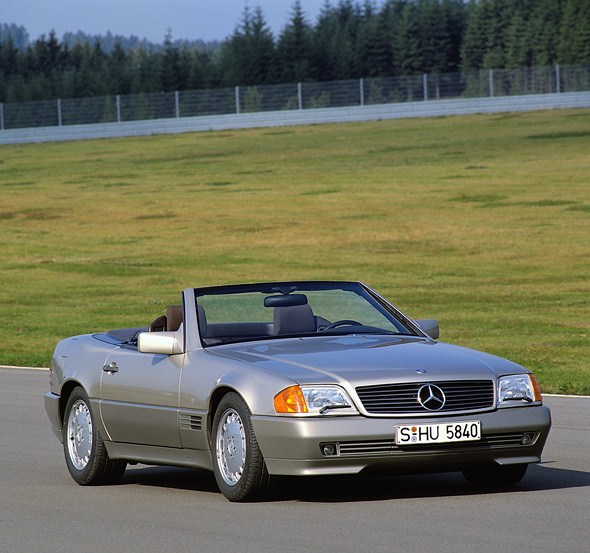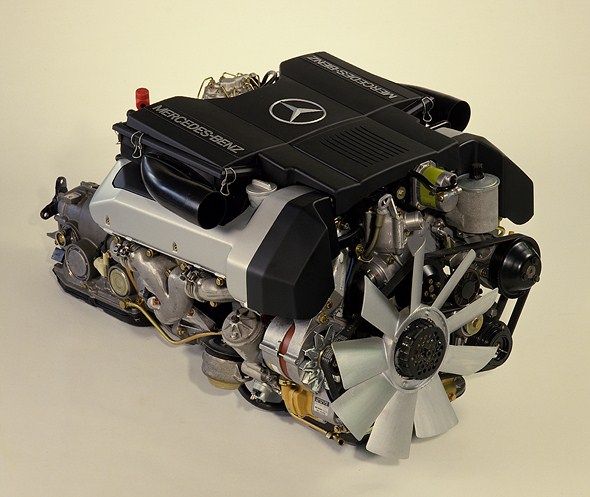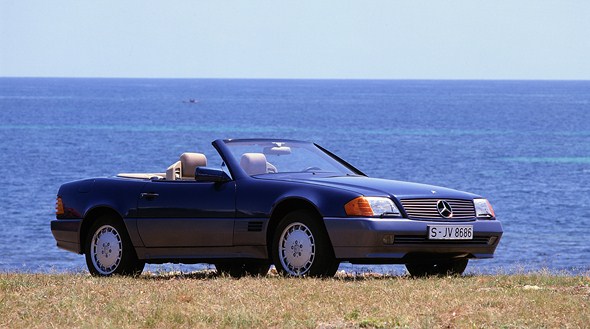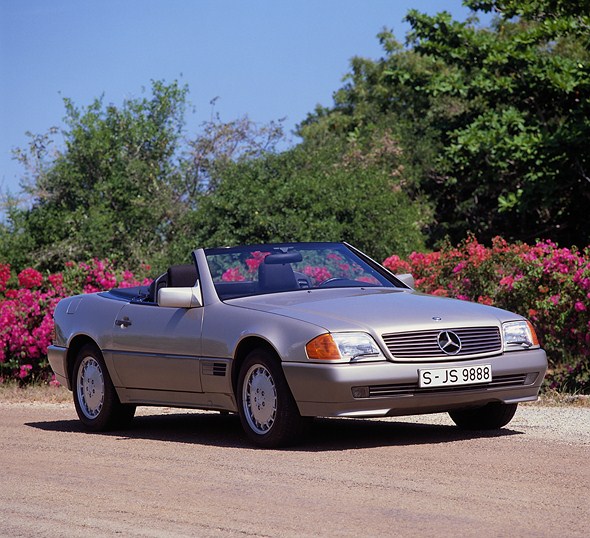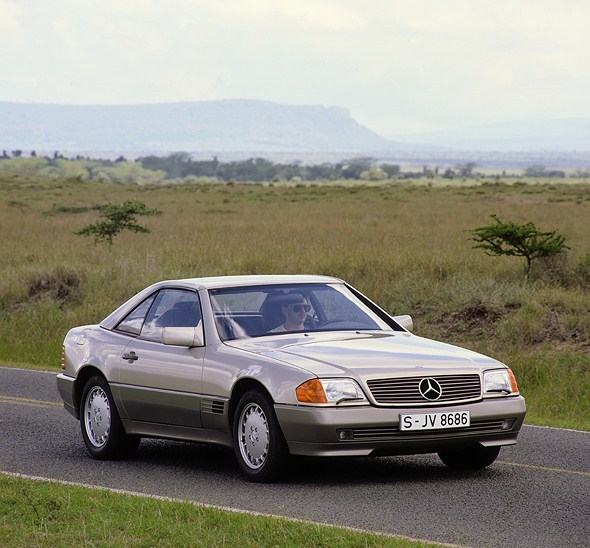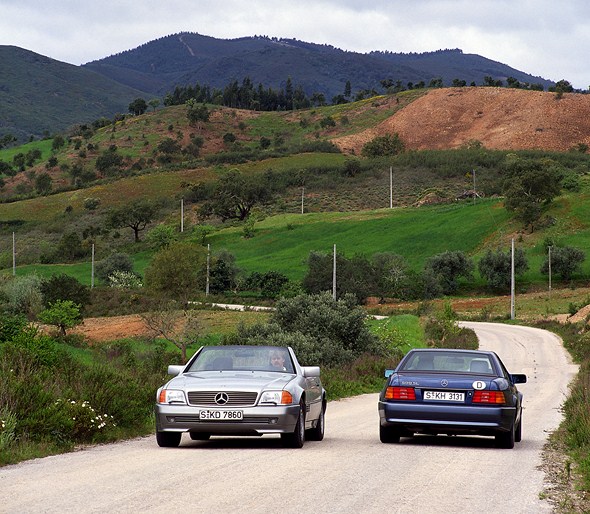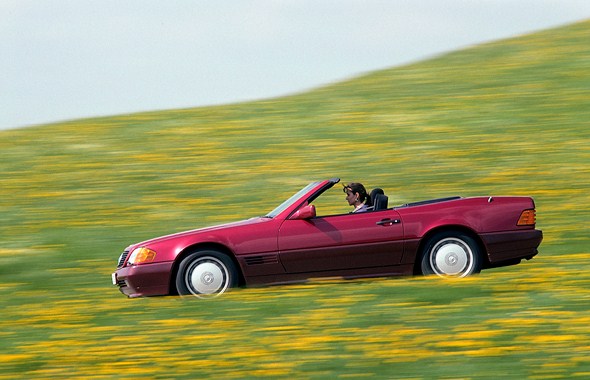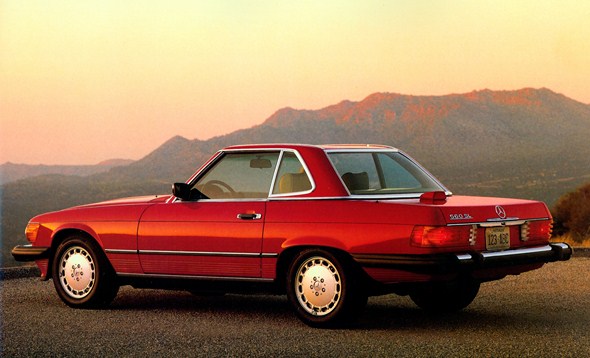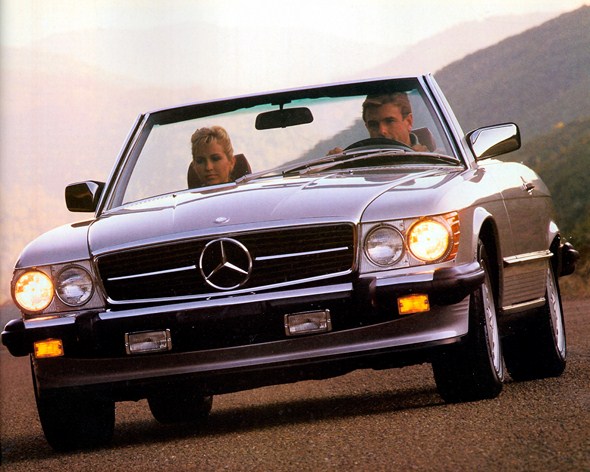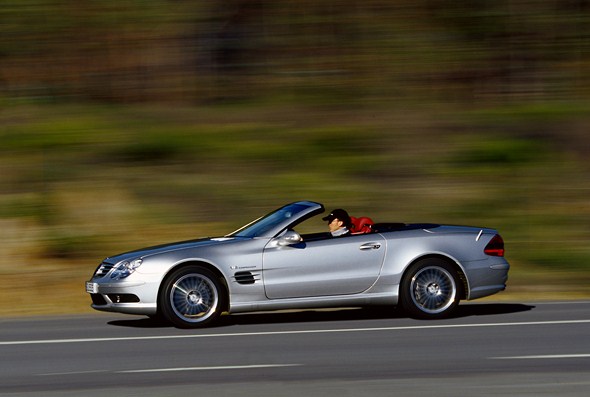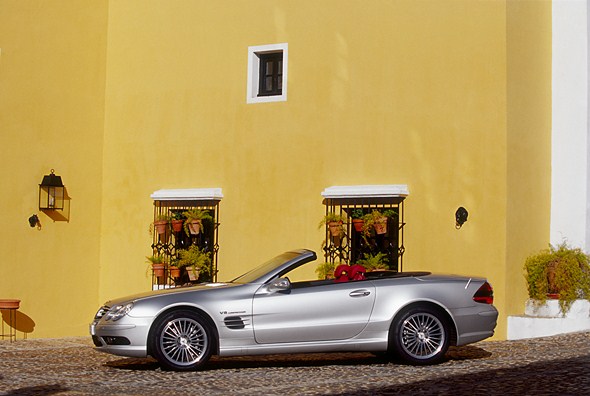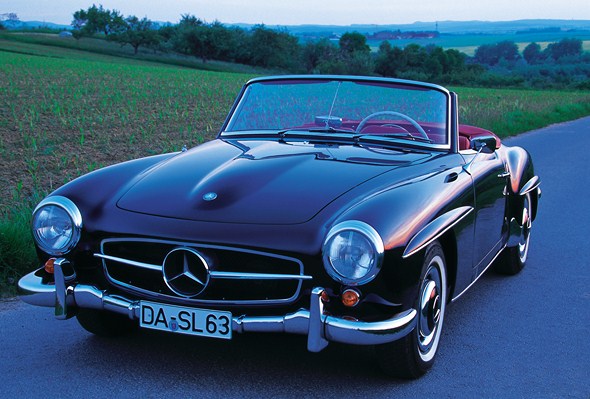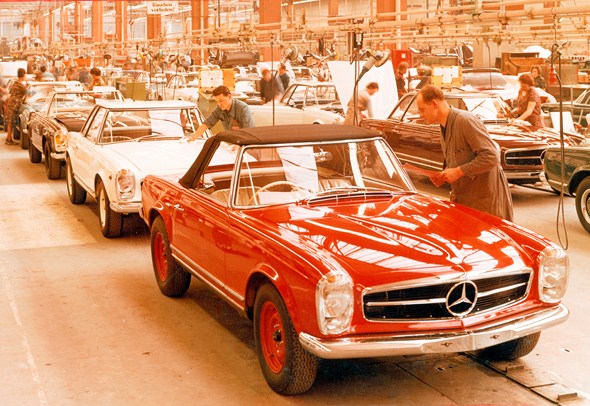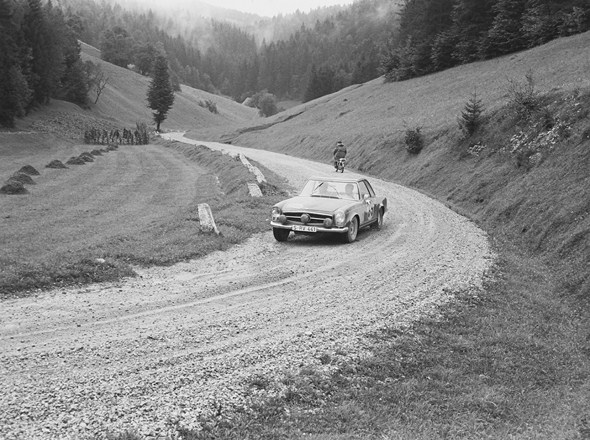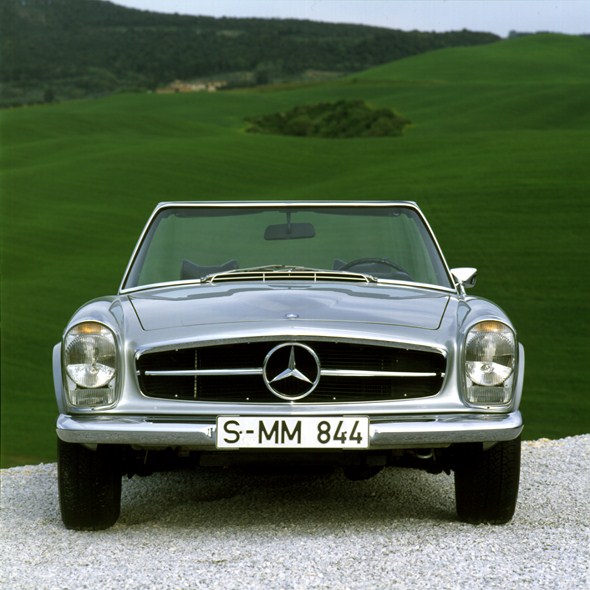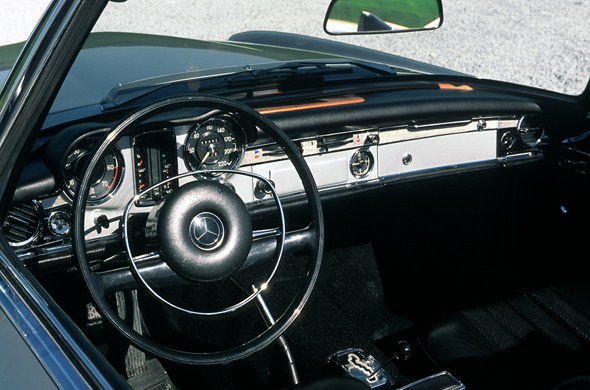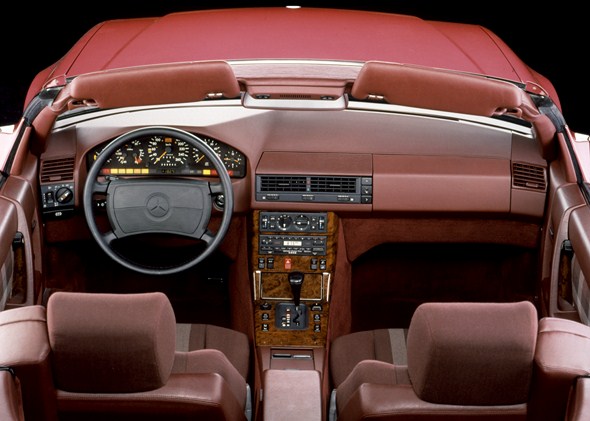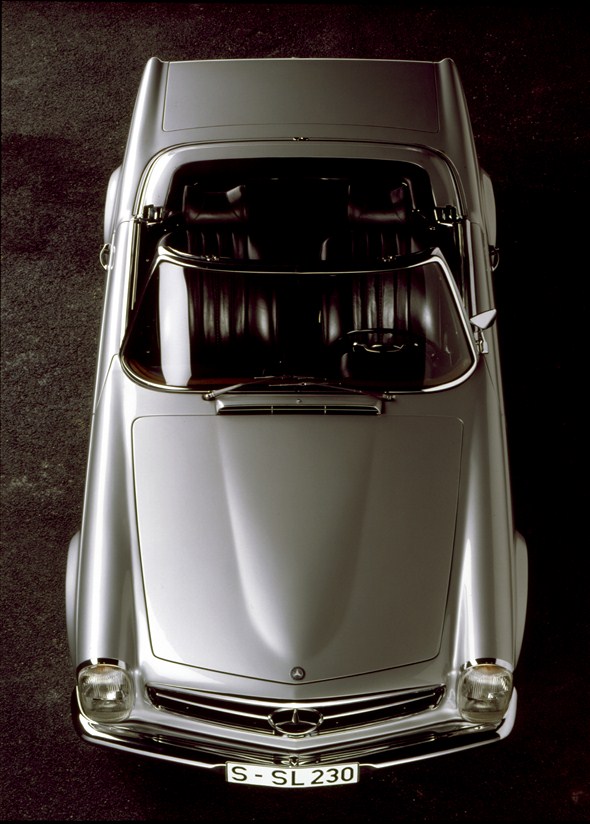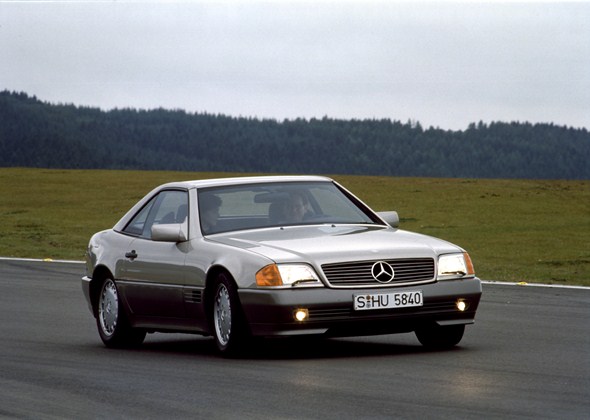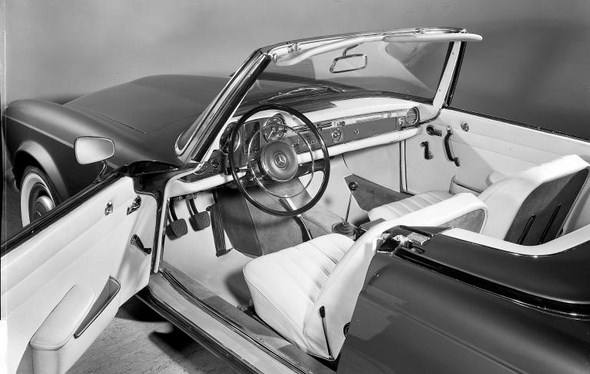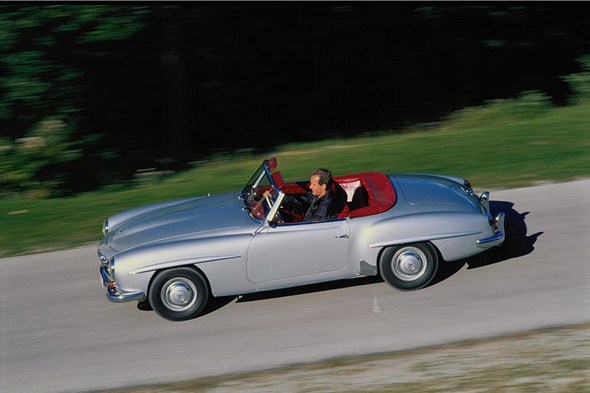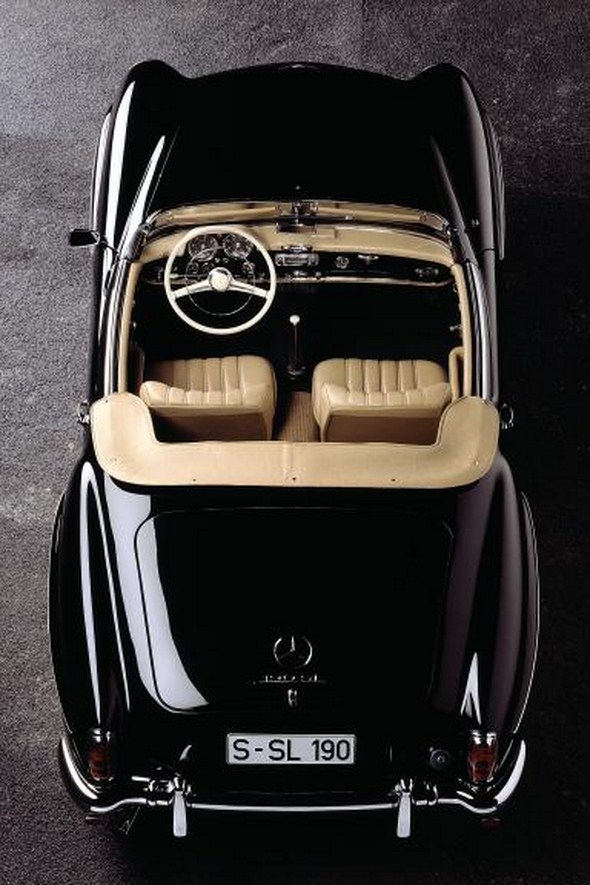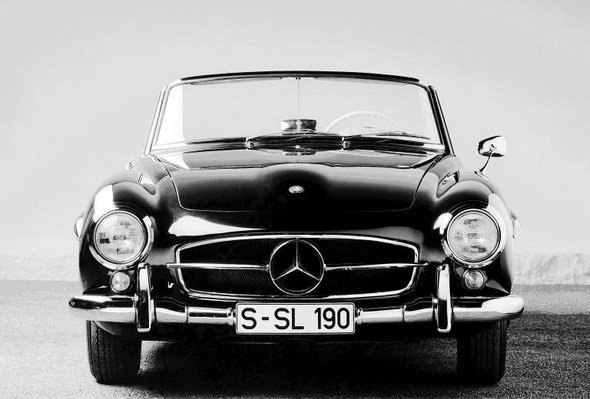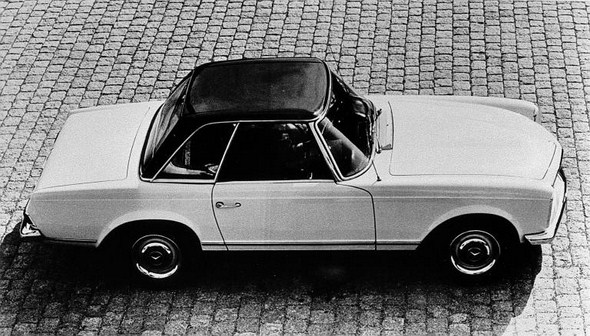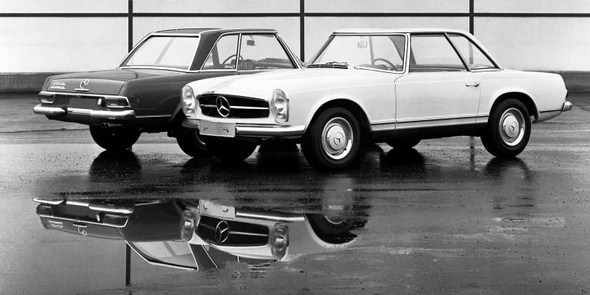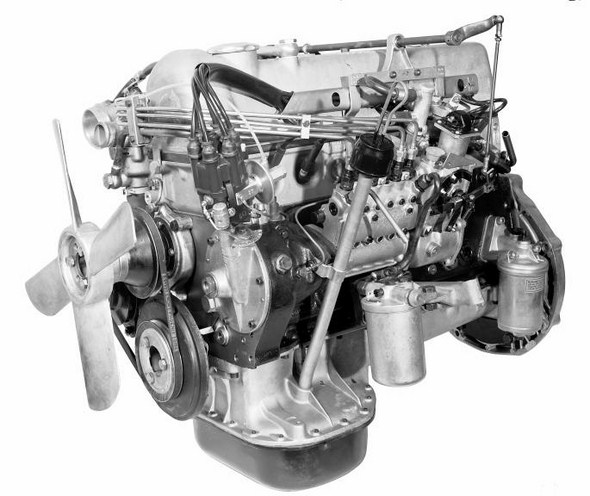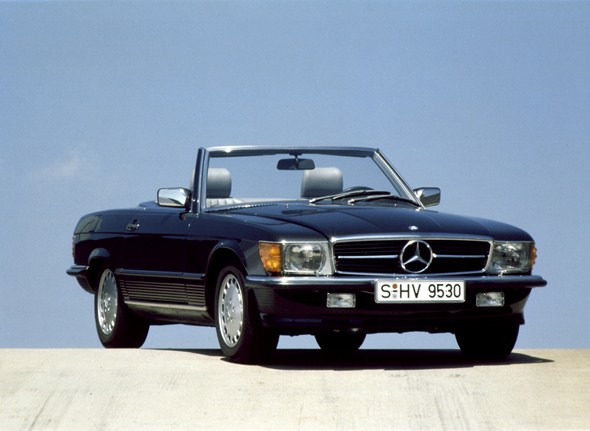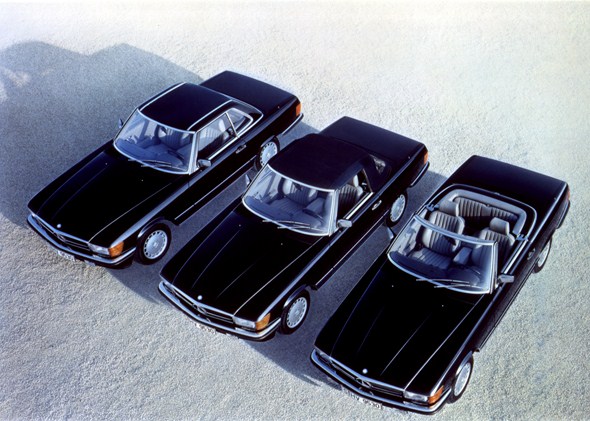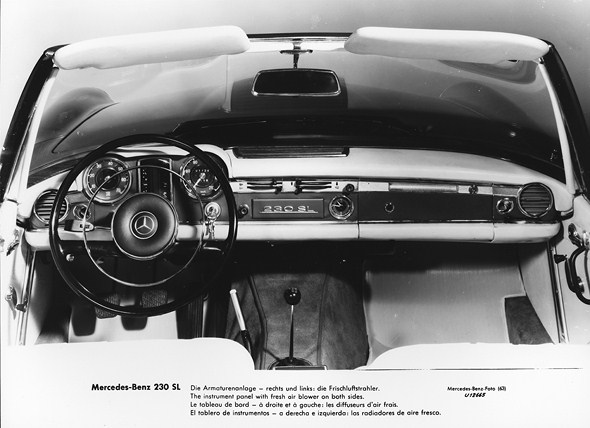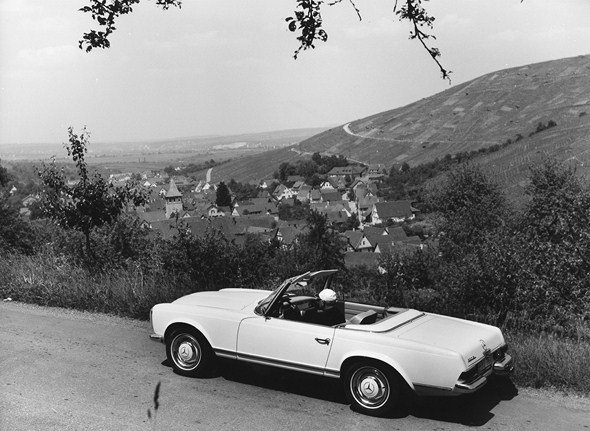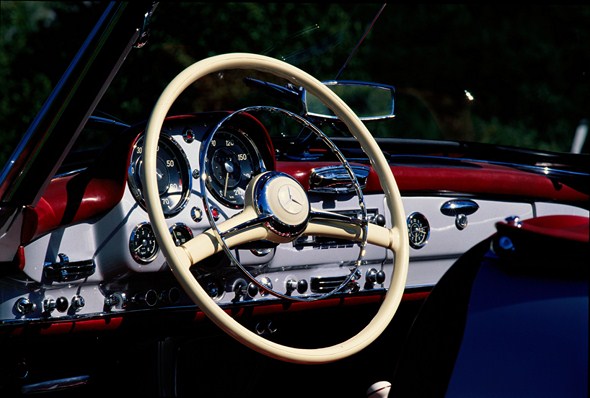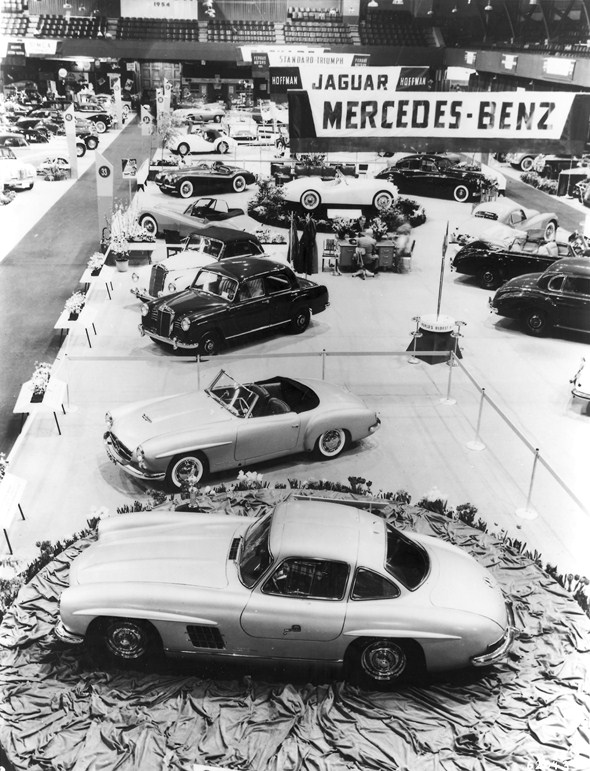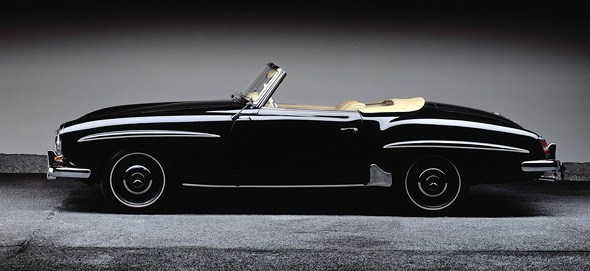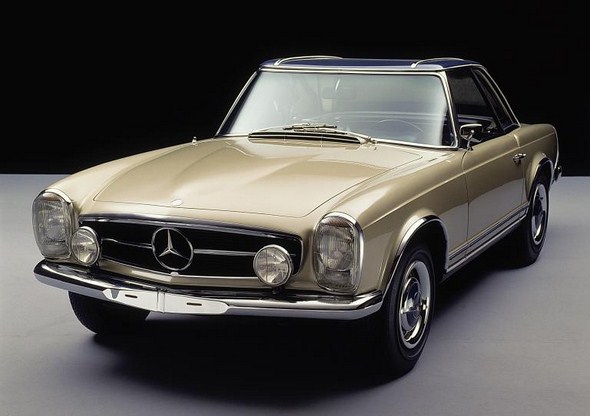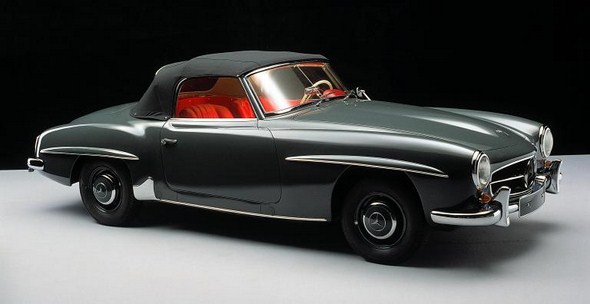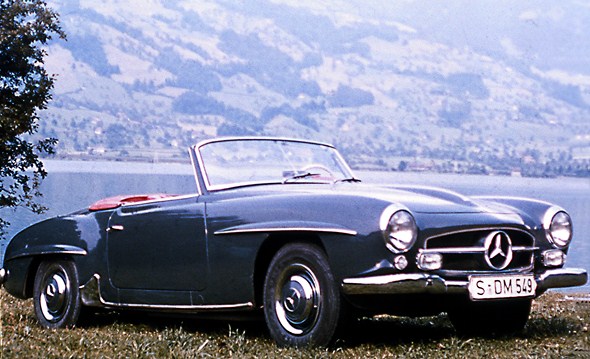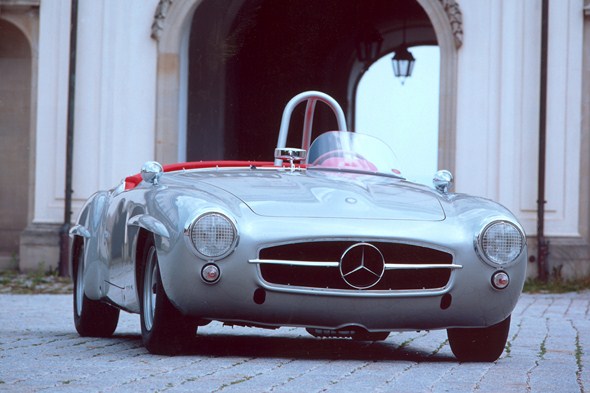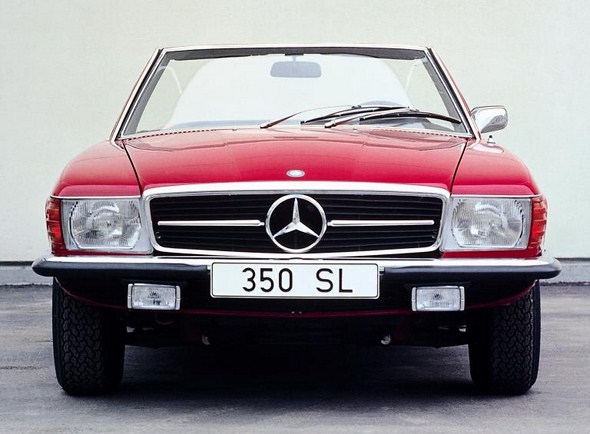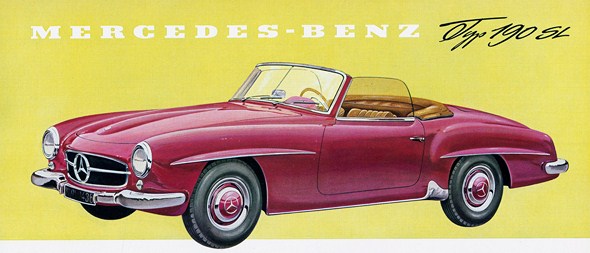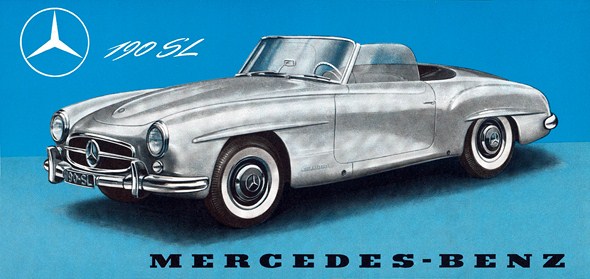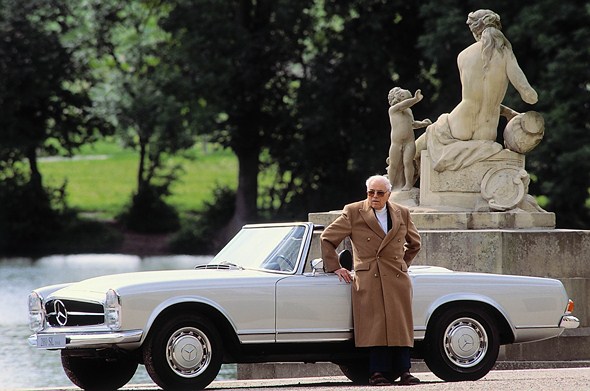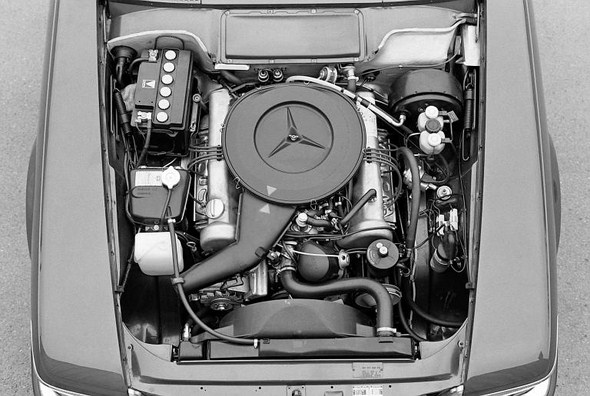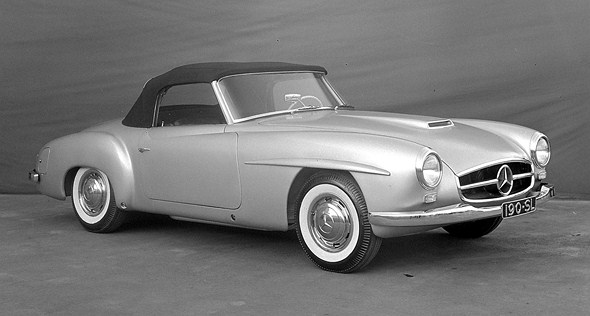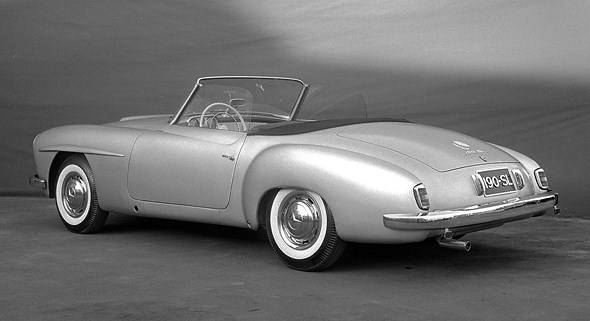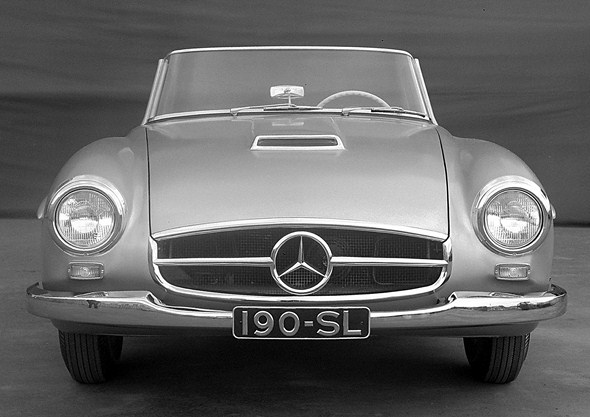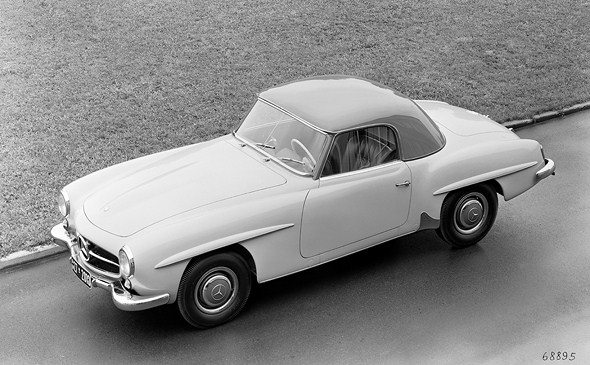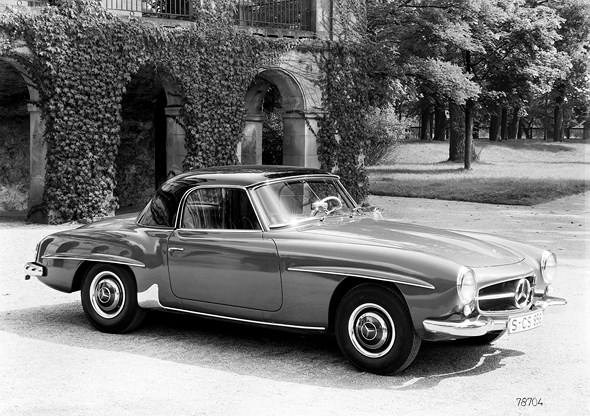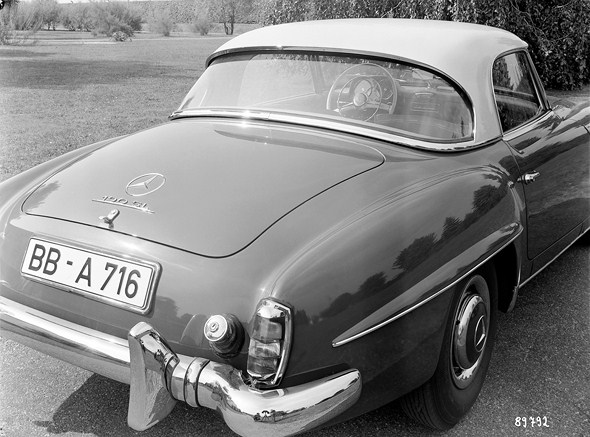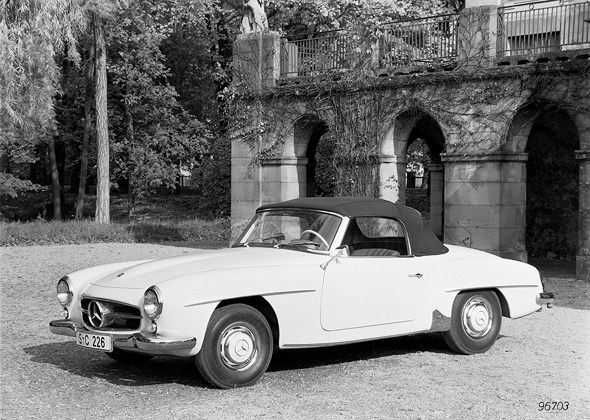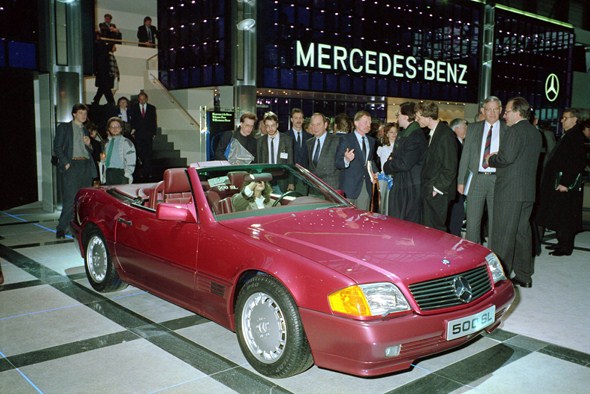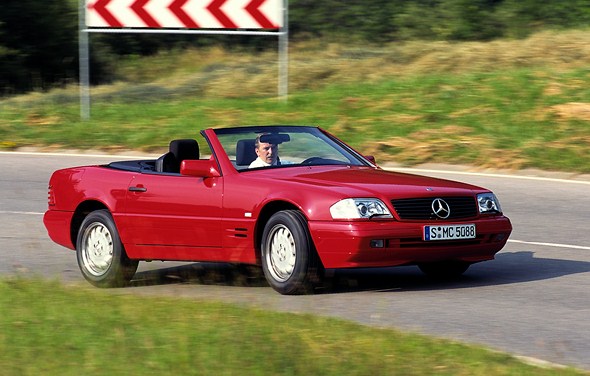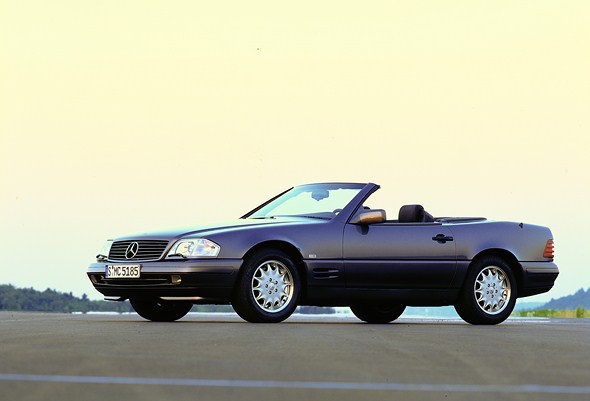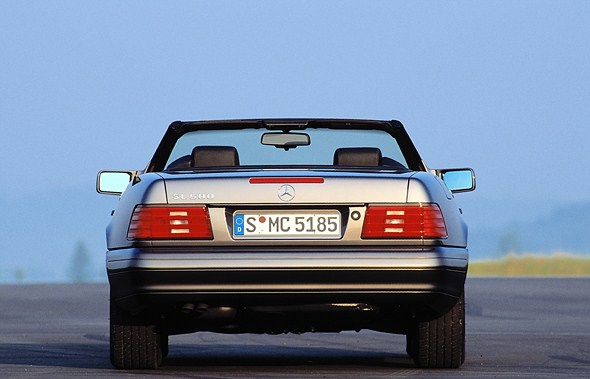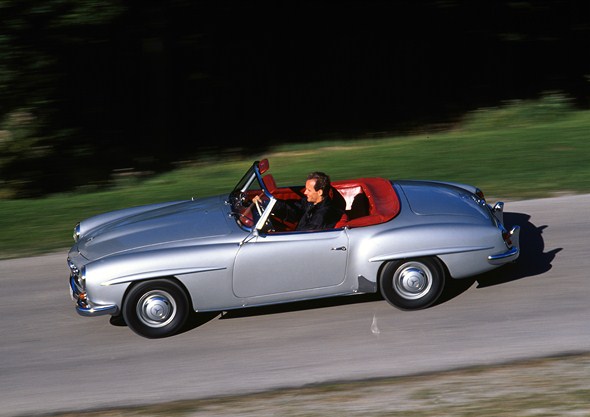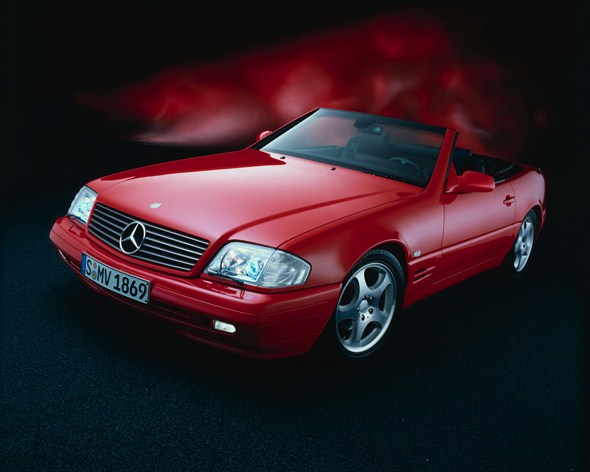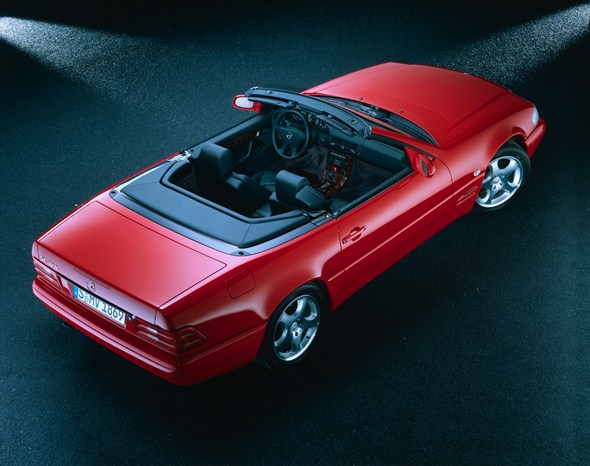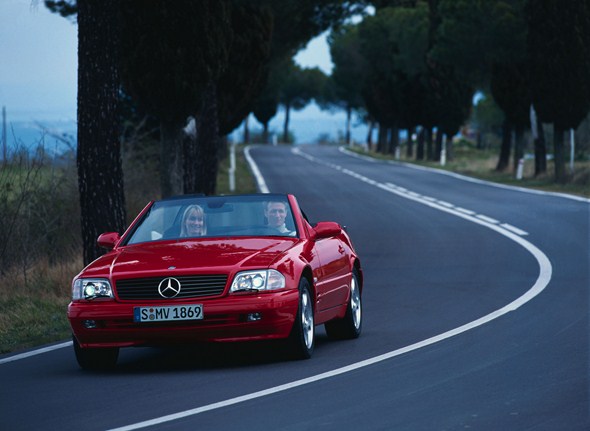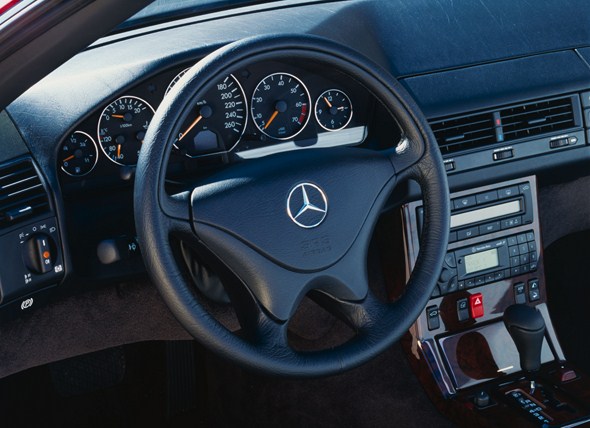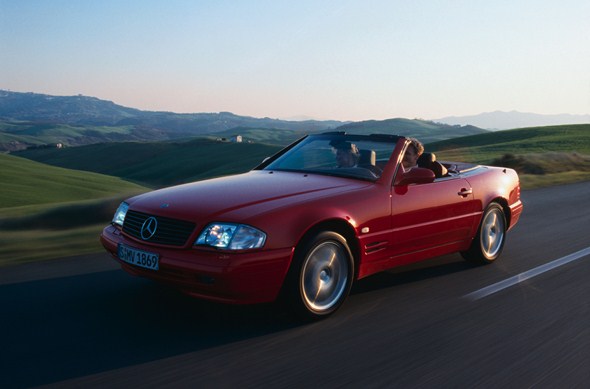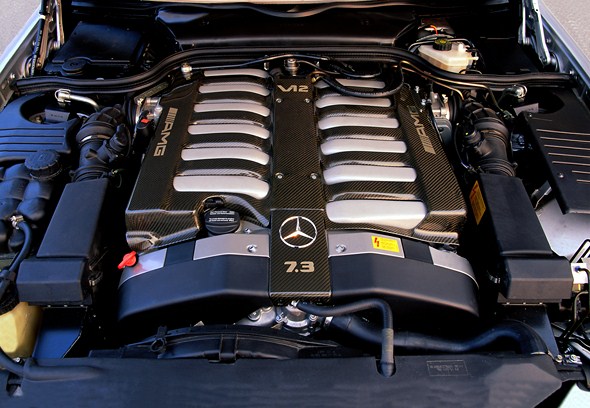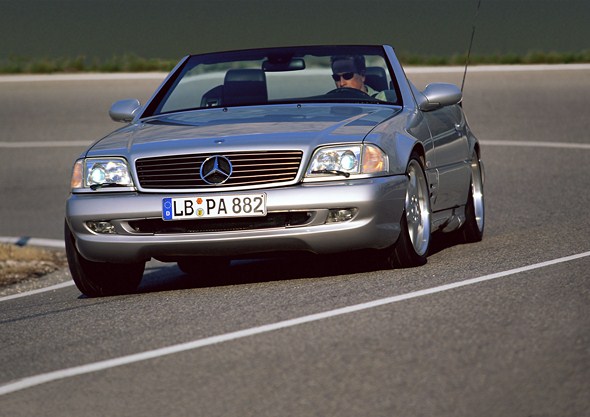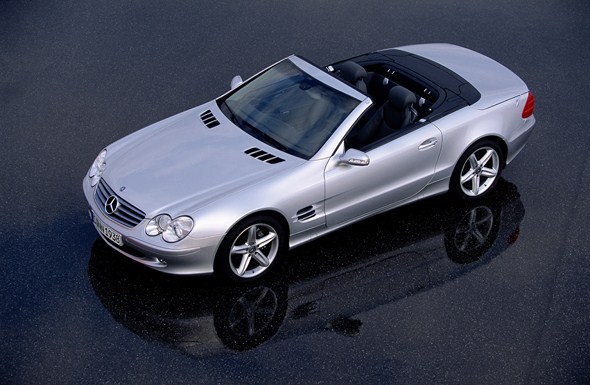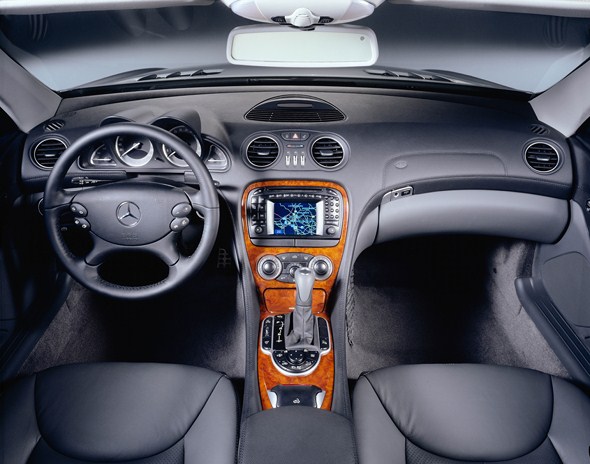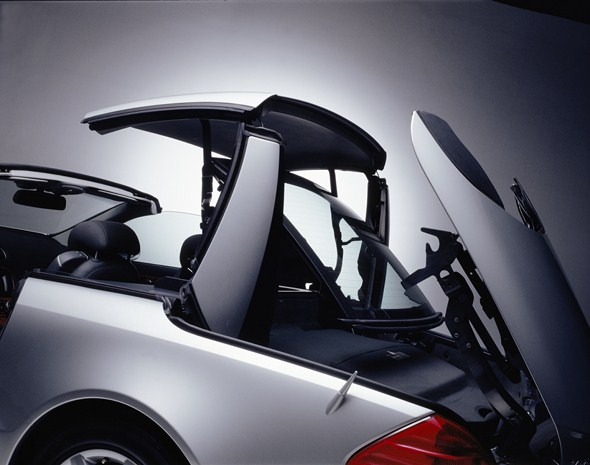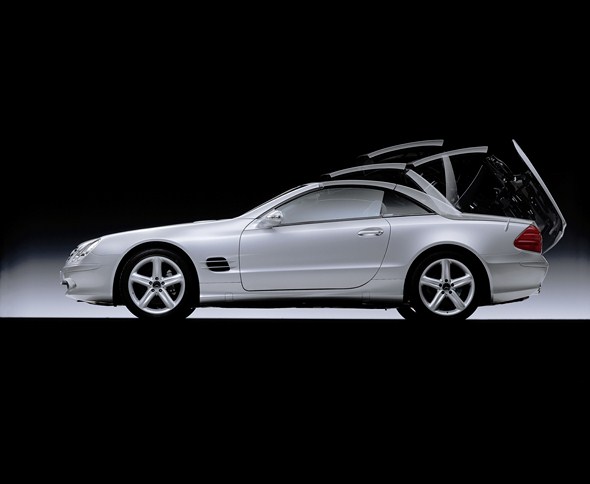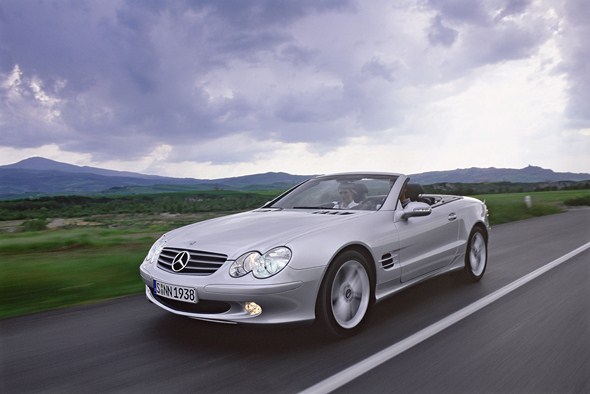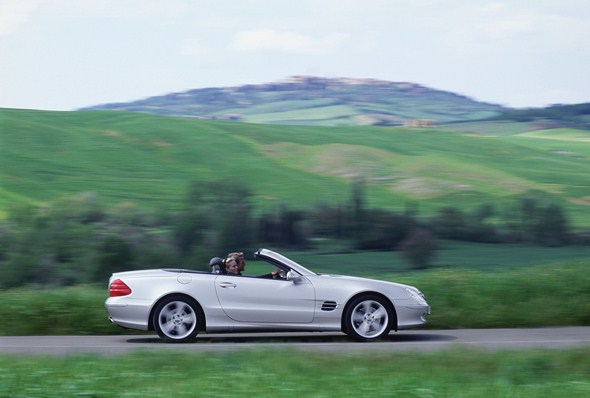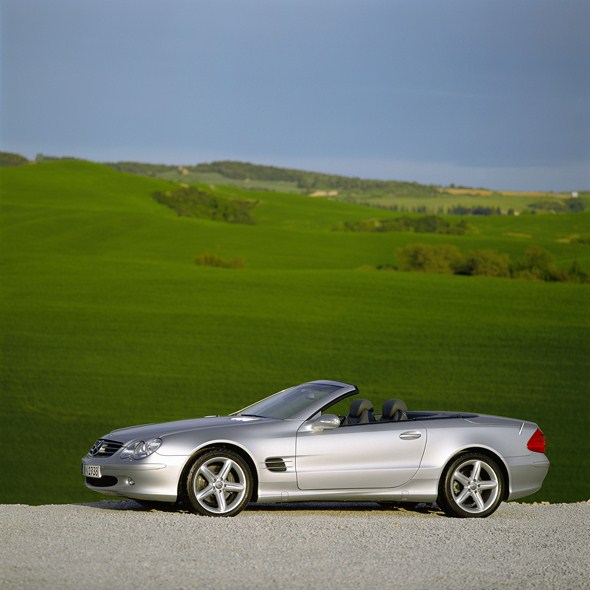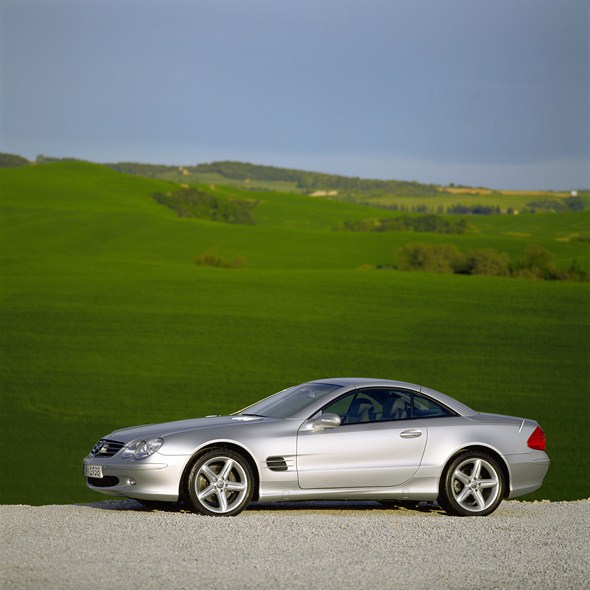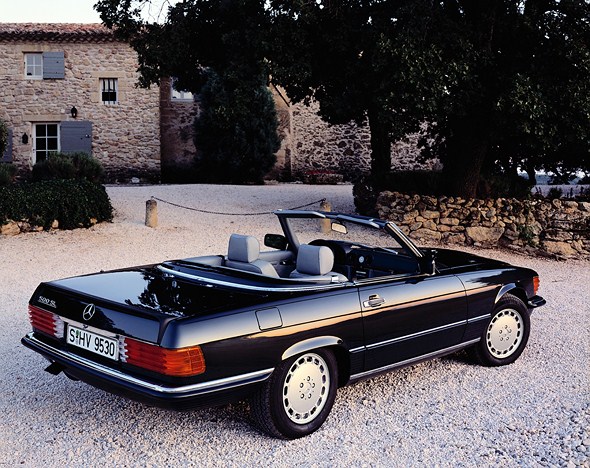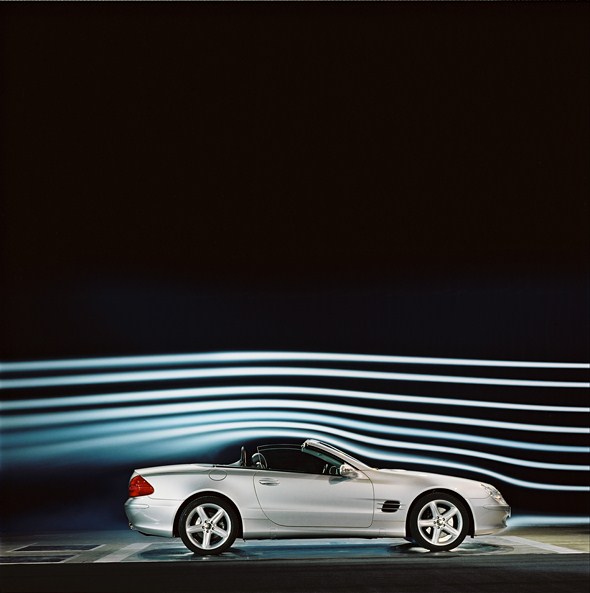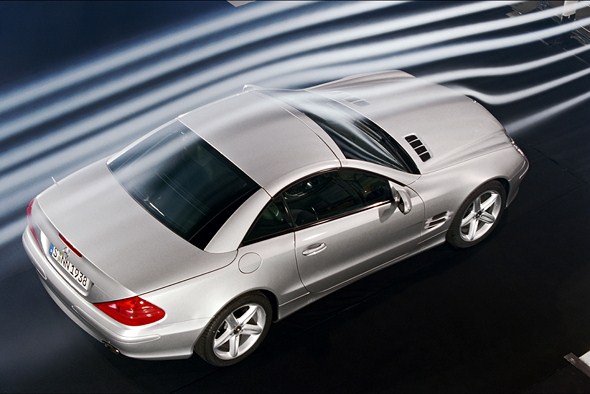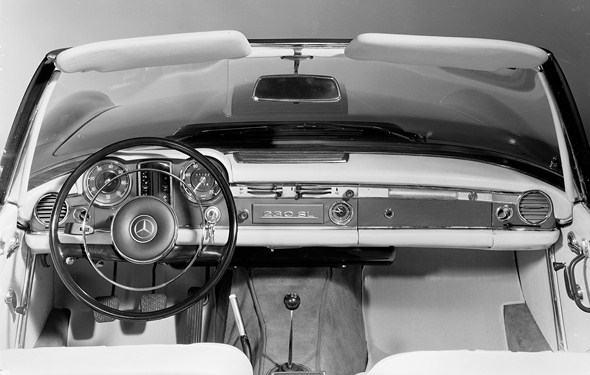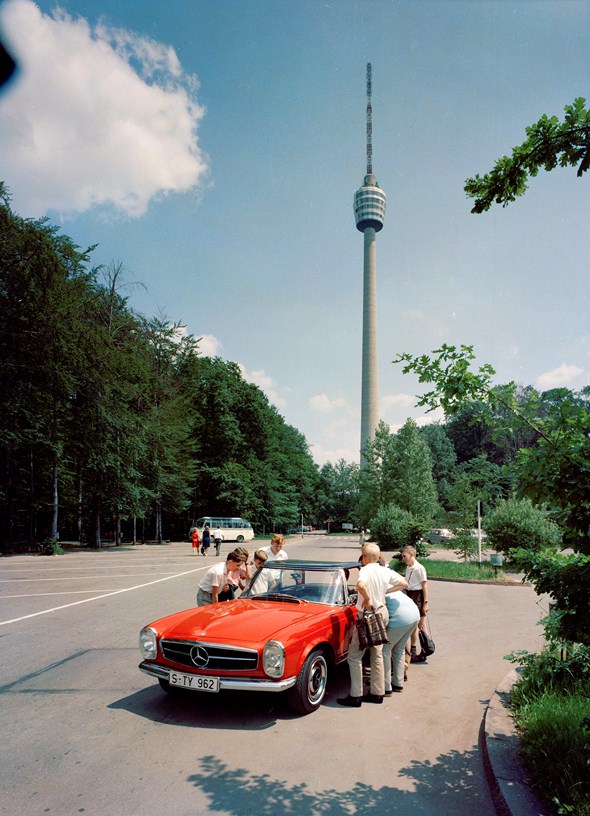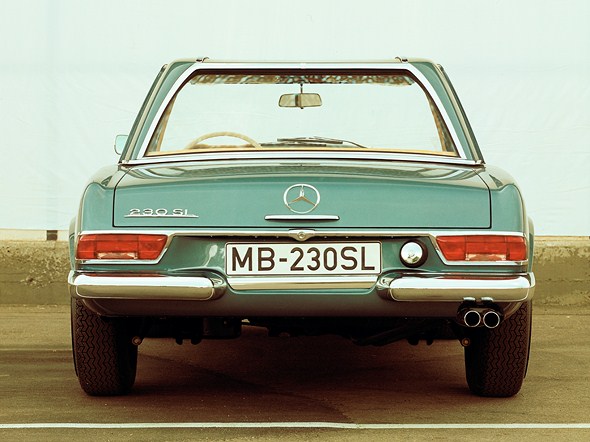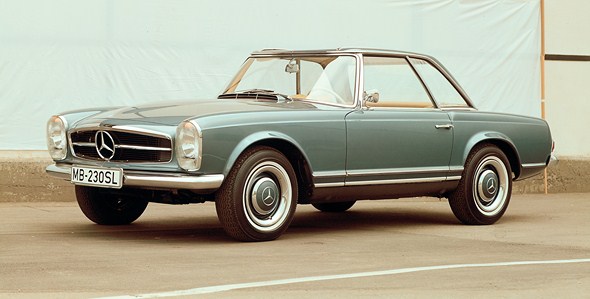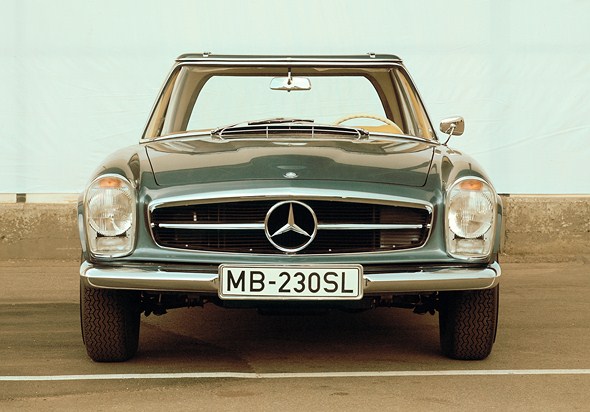NEWS
The touring sports cars of the SL-Class


The tradition of exceptional sports cars goes back to 1954
· Always also an innovation champion for the Mercedes-Benz brand
Stuttgart – The Mercedes-Benz SL-Class tradition took its start in the 1950s when the company presented the 190 SL (W 121 series), which it explicitly described as a touring sports car, at the International Motor Sports Show in New York.
Also on display at the show: the 300 SL (W 198 I), the famous ‘Gullwing’. It was derived from the competition sports car (W 194) with the same name, and, more uncompromising as it was, sooner could be categorised as a super sports car.
Yet the tremendous charisma of the Gullwing rubs off on the entire SL series to this day. Based on the Gullwing the open-top 300 SL Roadster (W 198 II), built parallel to the 190 SL, arrived in 1957.
An open-top two-seater thus became the classic body form of the SL family, whose model designation stands for the words “Super – Light”.
The 190 SL is the car more suited for everyday use. Bearing that in mind, and because of the fact that from the outset it was solely available with a folding soft top, it should be considered the forerunner of all subsequent SL series.
The company characterised it in the following words in January 1954: “The 190 SL is a touring sports car which can be used both as a touring car and a workaday vehicle, but also as a sports car, and additionally as one for smaller sporting events.
This vehicle, which we explicitly wish to describe as a touring sports car, thus offers the owner the possibility of using it as a two-seater for any purpose.” On another occasion the company stated: “We do not present our 190 SL touring car to you as the little brother of the 300 SL. Rather it is a top-quality product in its class….”
In 1963 the W 113 SL series appeared, called the “Pagoda SL” for the characteristic shape of its hardtop roof. In 1971 the R 107 series followed.
Because of its long production life of 18 years, it achieved the highest production volume to date of all SL series. In March 1989 Mercedes-Benz then introduced the R 129 series, which featured numerous technical innovations and carried the SL-Class into the new millennium.
After a production period of twelve years and two facelifts it was replaced in 2001 by the R 230 series – the first with a folding steel top.
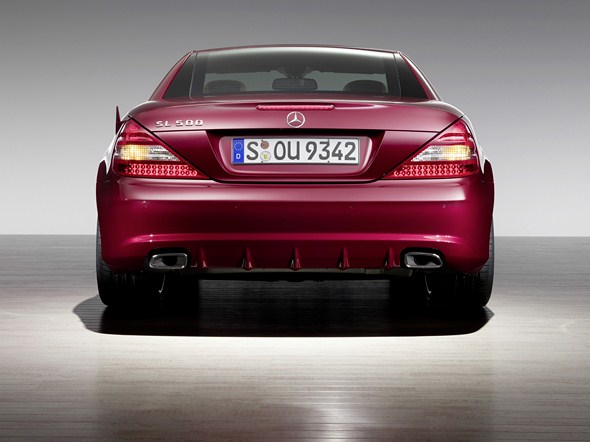
W 121 series (1955 to 1963)
· Modern four-cylinder with overhead camshaft
· Modern chassis for high ride comfort and great safety
· Retractable roadster soft top
W 113 series (1963 to 1971)
· Folding soft top operated with the greatest of ease
· Six-cylinder engine with six-plunger injection pump
· Automatic transmission available in an SL for the first time
· Safety body with stiff passenger cell and deformable front and rear segments
· Numerous other safety features such as an interior designed to reduce injury hazards in accidents and a buckling steering column
· Disc brakes on the front wheels, from 1967 also on the rear wheels
R 107 series (1971 to 1989)
· Further developed safety body
· Frame-floor unit with differing metal thicknesses to produce a carefully defined crumple pattern
· Sturdy roll-over protection: high-strength A-pillars and windscreen frame with bonded glass
· Special air ducting on the doors ensuring reduced soiling of the side windows and mirrors
· Contactless transistorised ignition, Bosch K-Jetronic, hydraulic valve play compensation (1975)
· First SL with catalytic converter (1985)
R 129 series (1989 to 2001)
· Automatic roll-over bar (deploying time: 0.3 seconds)
· Extremely sturdy integral seats
· Coefficient of drag 0.32 (with hardtop)
· Fully automatic electro-hydraulic folding soft top
· World premiere of the draught-stop
· Adaptive Damping System ADS (optional)
· Fixed-calliper disc brakes
· First twelve-cylinder engine in an SL (1992)
· Electronic Stability Program ESP® (1995)
· Brake Assist BAS (1996)
· Cruise control effective even in 30 km/h zones (1996)
R 230 series (from 2001)
· Vario-roof with ingenious swivelling mechanism and 16 seconds folding time
·
Sensor-controlled roll-over bar fully operable even with the vario-roof closed
· Electro-hydraulically controlled braking system Sensotronic Brake Control (SBC™)
· Suspension with Active Body Control ABC
· New type of head/thorax airbags in the doors
· Coefficient of drag 0.29 (closed vehicle)
· Use of lightweight components for best fuel economy
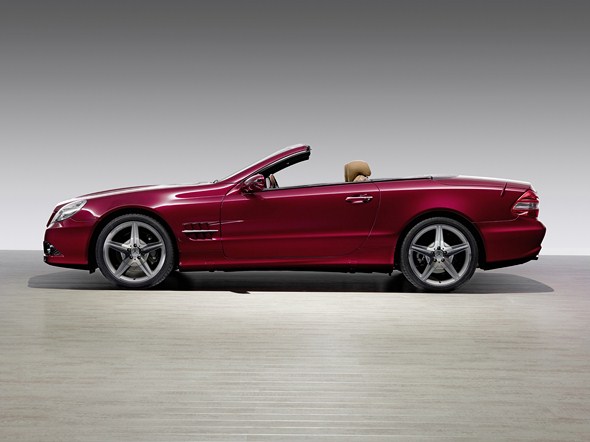
Mercedes-Benz 190 SL (W 121 series, 1955 to 1963)
Daimler-Benz AG introduced the Mercedes-Benz 190 SL in February 1954 at the International Motor Sport Show in New York.
It was designed as a touring sports car “which owing to its high comfort is intended for a class of customers who want to travel large distances themselves at high cruising speeds in this externally very sporty looking car,” as design engineer Josef Müller wrote in retrospect in 1957 – that can be said of every SL series since.
Simultaneously the Mercedes-Benz 300 SL “Gullwing” debuted in New York. As an exciting super sports car it too lent the SL series its character.
The body design of the 190 SL closely followed that of the Gullwing, but it was constructed as a two-seater cabriolet and had a retractable soft top.
An optional third seat could be fitted in the rear, at right angles to the direction of travel. There were three versions: a car with a fabric top and a coupé with removable hardtop, optionally with or without a fabric top. The 190 SL was given the internal series designation W 121, like the 190 Saloon that appeared a little later in 1956.
The 190 SL is technically related to the “Ponton” (pontoon) saloons – commonly called that because of their characteristic body shape – of the W 120/121 series.
The chassis, for example, featured the familiar low-pivot single-joint swing axle and the front wheel suspension including subframe The shortened floor assembly also came from the Saloon.
A new development was the 1.9-litre petrol engine. The four-cylinder unit has a single overhead camshaft and is regarded as the progenitor of an entire family of engines.
In the Mercedes-Benz 190 SL it developed 77 kW and accelerated the fabric-topped variant from 0 to 100 km/h in 14.5 seconds. The top speed was 170 km/h.
During its production life the 190 SL underwent many improvements in details. The Sindelfingen plant built the last unit in 1963 after a total production run of 25,881 vehicles.
Mercedes-Benz W 113 series (1963 to 1971)
At the 1963 Geneva Motor Show Mercedes-Benz presented the new 230 SL – internal series designation W 113. It was designed as a comfortable high-performance two-seater touring car and replaced the 190 SL and 300 SL models.
Three versions were available: an open-top car with a folding soft top, an open-top version with hardtop, and finally the hardtop coupé.
The hardtop coupé had no soft top and soft-top compartment, but in exchange more room for luggage. All three versions could be driven with the top open. As an optional extra a transverse rear seat was available.
The exterior of the 230 SL is characterised by clear, straight lines and the unmistakable SL face including the large, centrally positioned Mercedes star.
The hardtop with high windows and a roof borne up only by slim pillars conveys an impression of lightness; with its inwardly directed curvature it reminds one of Far Eastern temples, and straightaway the car had a nickname: “Pagoda”.
The “Pagoda” is the first SL in which speed combined with safety. Since its basis is the floor unit of the famed “Tailfin”, the world’s first saloon with a safety body, this SL also had a stiff passenger cell and crumple zones in the form of easily deformable front and rear segments.
As in the Saloon the interior was designed so as to reduce injury hazards in accidents, meaning that there were no hard corners and edges.
As in the previous model, seat belts were available as an optional extra. The steering gear was moved from the crash-imperilled front section to the firewall; the steering column yields to axial compression and additionally features a joint that prevents the feared lance effect in an accident.
In 1967 the telescoping safety steering column and the impact absorber in the steering wheel were added.
The chassis, adopted from the 220 SE Saloon, is tuned to the requirements of the sporty car.
The suspension is taut, but for a sports car almost atypically comfortable. The six-cylinder, which also came from the Saloon, was modified for use in the SL. The engine, its bore enlarged to give it a displacement of 2.3 litres, developed 110 kW and was designed very sportily.
The successor to the 230 SL was the Mercedes-Benz 250 SL in 1967. The changes concerned mainly the engine and the braking system.
The engine, its displacement enlarged by 200 cubic centimetres, had the same output, 110 kW, but ten percent more torque. The 250 SL thus was appreciably more flexible in its response.
In addition to the three body versions known from the 230 SL, the 250 SL was available as an optional extra in a fourth version, a Coupé with rear seat bench, shown for the first time in March 1967 at the Geneva Motor Show.
Less than a year after the presentation of the 250 SL, it was replaced by the 280 SL with a 2.8-litre engine and 125 kW. All in all, from 1963 to 1971 a total of 48,912 “Pagodas” were built – remarkable for a sports car with such high standards.
Mercedes-Benz R 107 series (1971 to 1989)
The R 107-series SL rolled out on the highway in spring 1971, first as 350 SL (147 kW), from autumn 1971 also as 450 SL (165 kW). For the first time in the history of the SL series an eight-cylinder power plant did duty under the bonnet.
Parallel to it the corresponding Coupé models of the SLC series (C 107 series) were built up until autumn 1981.
Besides elegance and quality the vehicles radiated safety, since the crash behaviour of the two-seater was far ahead of its time.
Technically, this became apparent in a carefully defined crumple behaviour of body and bodyshell, a high-strength A-pillar, and interior appointments uncompromisingly designed according to safety criteria.
During its 18-year “lifetime”, which was not planned to last that long, but in the end was indeed successful, this SL got a whole series of six- and eight-cylinder engines.
Its model designations accordingly are quite varied. In July 1974, in response to the oil crisis the 280 SL (136 kW) followed. So three SL engines now were available – nowadays nothing unusual, but in those days something new in the history of this model category.
In the course of time all engines underwent modifications (and got slightly changed performance figures) for better compliance with the emission standards, which meanwhile also had become stiffer in most European countries.
In September 1977 Mercedes-Benz launched the 450 SLC 5.0 with a V8 engine enlarged to a displacement of five litres and an output of 177 kW.
In a comprehensive facelift it was renamed 500 SL in 1980, and the 350 SL was superseded by the 380 SL (160 kW). In the following years the engines were again revised.
A further package of model refinements in 1985 brought the 300 SL (138 kW) as successor to the 280 SL, and all engines were then available with a catalytic converter as an optional extra.
New to the range was the 420 SL with V8 engine (160 kW without, 150 kW with catalytic converter). The most spectacular new product was the 560 SL (170 kW), reserved to the export markets USA, Australia and Japan.
Production of the R 107 series ended in August 1989, more than 18 years after the production start-up of the 350 SL. With that this SL series set an internal record that probably never will be broken: in the entire history of the company no other passenger car series has ever been produced over such a long period.
All told, in Sindelfingen 237,287 open-top cars were built, a number which impressively demonstrates the great popularity of the 107 series. Of the Coupé a total of 62,888 were built from 1971 to 1981.
Mercedes-Benz R 129 series (1989 to 2001)
At the 1989 Geneva Motor Show Mercedes-Benz presented the SL of the R 129 series. The first models were the 300 SL (140 kW), 300 SL-24 (170 kW) and 500 SL (240 kW).
The stylistically assured, no-frills lines of the slightly wedge-shaped body, the flared wheel arches, the half-spoilers forward of the front wheels, a very slanted windscreen, the skilfully modelled rear end and the standard-fit light-alloy wheels produced an exceedingly harmonic overall effect.
The brand scored a hit with the vehicle. Production capacity soon was stretched to the limit and delivery periods of several years had to be accepted.
New standards were set by this car in the area of safety. The results of Mercedes-Benz’s rigorous frontal and rear-impact crash tests for the open-top vehicle were sensational.
Integral parts of the safety concept are also the automatic roll-over bar, which pops up, sensor-controlled, within 0.3 seconds when a roll-over threatens, as well as the integral seats, whose resistance in a crash is many times higher than the possibly occurring forces.
The suspension was adapted to the requirements of a touring sports car and enables precise handling and fast driving combined with high comfort.
In autumn 1992 another model appeared, the 600 SL with twelve-cylinder engine and 290 kW.
A first facelift in autumn 1995 brought a slightly modified body design, more extensive standard equipment, and more refined engineering.
A second facelift in 1998 employed discreet stylistic touch-ups to give the sports car an even more dynamic look, but mainly meant a change in the engine range, with new six-cylinder V-engines in place of the previous in-line engines, and a new V8 power plant.
The models now offered for sale were the SL 280 (150 kW), SL 320 (165 kW) and SL 500 (225 kW), along with the SL 600 with an unchanged output.
Additionally there were the uprated models SL 60 AMG (280 kW), which first came out on the market as the AMG 500 SL 6.0, as well as the SL 55 AMG (260 kW) and SL 73 AMG (386 kW) – products of the cooperation with AMG that started in 1990.
In summer 2001 production of the R 129 series came to an end after twelve years and a total of 204,940 units. In terms of overall volume it was not quite as successful as its predecessor from the R 107 series (237,287 units); but if average annual production is compared, the R 129 series with some 16,500 units takes a very clear lead.
Mercedes-Benz R 230 series (from 2001)
The most conspicuous innovation in the next SL generation with the internal designation R 230 is the vario-roof: for the first time in the history of this model series it enabled an open-top car and a coupé in one – the transformation takes place within 16 seconds.
The first model presented to the public in summer 2001 was the SL 500 (225 kW); in the autumn it was joined by the SL 55 AMG (350 kW). In 2002 the SL 350 (180 kW) followed, and in 2003 the SL 600 (386 kW).
The design of the R 230 series blends tradition and future through distinctive details. For instance, the air intakes in the front wings take up a typical feature of the 300 SL from the 1950s. The thin, wing-like segments on these side air intakes – called fins by experts – also are a reminiscence.
Ever since the “Pagoda” the abbreviation SL is synonymous with pioneering achievements in the areas of active and passive safety in open-top sports cars.

With an entirely new, comprehensive concept the R 230-series SL clearly outstrips the previous safety standards.
The concept includes electronic handling dynamics systems like Sensotronic Brake Control SBC™, Active Body Control ABC, Brake Assist BAS, acceleration skid control ASR, or ESP® and extends to the structural integrity of the body in every conceivable type of accident.
A few other things contributing to occupant protection are two-stage airbags for driver and front passenger, head/thorax bags in the doors, integral seats, high-performance belt tensioners, belt force limiters, and the sensor-controlled roll-over bar, which goes into action even when the vario-roof is closed.
The first facelift came in 2006. It brought the SL 500 a 285 kW V8 engine and the SL 350 a 200 kW V6 – both new developments. The output of the SL 600 is now 380 kW. The seven-speed automatic transmission 7G-TRONIC is standard equipment.
The most conspicuous element of a further model refinement package in 2008 was the new front design, which adapted the SL to the brand’s current car design. Also, the SL 280 (170 kW) was added to the range.
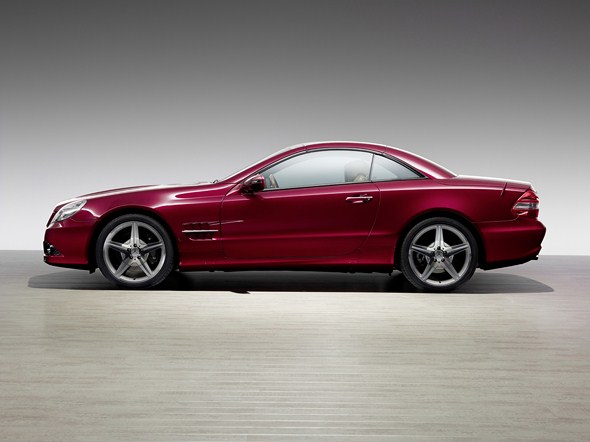
The touring sports car at the side of the super sports car 300 SL
· A sporty elegant two-seater touring and utility car
· USA an important market for the vehicle
The story of the Mercedes-Benz 190 SL starts with Maximilian Hoffman. He was the Mercedes-Benz brand’s official importer for the US market in New York since 1952.
When the company presented him two ideas in early September 1953 – bring the 300 SL racing sports coupé (W 194 series) as a production vehicle and simultaneously team it up with an open-top touring sports car – he recognised the potential for sales in the USA.
At the time, however, Daimler-Benz was completely absorbed in other design and development activities – for production vehicles and also for the 1954 racing season, for which the new formula racing car of the W 196 R series was earmarked.
The pressures of work even made the Stuttgart people put off their plans to participate in sports car racing in 1953. So the new SL models increased the pressure, but they were important for the image of Mercedes-Benz – the 1950s marked the beginning of a new era after the Second World War.
And these were interesting cars too because Mercedes-Benz lacked sporty vehicles in its range. Already in mid September 1953, the Board of Management made a decision: the road version of the 300 SL (W 198 I) would come out along with a smaller, open-top sports car, the 190 SL (W 121).
About five months after the decision the touring sports car and the super sports car were to celebrate their premieres – in America, at the International Motor Sports Show in New York, taking place there from 6 to 14 February 1954.
At the time it was the most important motor show on the other side of the Atlantic. This meant that the engineers had very little time for development.
So they had to hurry: a few days after the Board’s decision to build both vehicles, the directors of Daimler-Benz were examining the first sketches, and two weeks further on they were able to assess the first 1:10 scale model, which was followed eight weeks later by a full-scale model.
And the pace of development was raised still further. The floor assembly, which came from the Mercedes-Benz 180, had to be adapted to the new ideas and the right engine had to be found. Moreover, the tight time schedule stipulated that the contours of the planers on which the body would be created be finalised by 31 October 1953.
The race against time was won: Mercedes-Benz registered a tremendously favourable response to both vehicles at the show.
Up until then, the bodies of various models also were available in the two-seater A-version as Cabriolet, Roadster or Coupé, the most recent example being the Mercedes-Benz 220 Cabriolet A (W 187).
According to chief engineer Fritz Nallinger, this body variant would be replaced in future by the SL vehicles – no longer with the existing formal lines and face and explicitly in the SL design, including the star placed centrally on the radiator grille – a paradigm change in the model structure.
The 190 SL was thus the symbol of a new product philosophy and the forefather of the SL-Class.
First, series production of the Mercedes-Benz 300 SL began in August 1954 at the Sindelfingen plant.
The 190 SL, on the other hand, was thoroughly revised once more because the car displayed at the International Motor Sports Show in New York was neither technically tested nor stylistically mature.
In March 1955 Daimler-Benz then presented the final model of the touring sports car at the Geneva Motor Show. The body was designed by Walter Häcker and closely followed the design of the Gullwing Coupé 300 SL, but unlike the 300 SL the 190 SL had a retractable soft top.
The production body showed some clear differences from the show car: the stylised intake scoop on the bonnet was dropped; the forward edge of the bonnet had been moved farther back; there were “eyebrows” above the rear wheel cut-outs too; and the bumpers, indicators and tail lights were modified.
The Sindelfingen factory built the pre-production series starting in January 1955. Standard production commenced in May.
A body all in the style of the 1950s
The 190 SL is technically related to the “Ponton” (pontoon) saloons – commonly called that because of their characteristic body shape – of the W 120/121 series. Internally they were designated W 121, and the 190 that appeared in 1956 also got that designation. From the beginning the 190 SL was designed as a two-seater cabriolet.
In the 1950s the meaning of the term “roadster” changed. The classic roadster is a rather spartanly appointed sporty two-seater having detachable side windows, for instance, and a removable fabric top cum roof frame.
But the customers’ comfort standards now were higher, and the touring sports car Mercedes-Benz 190 SL made allowance for this. Though not a roadster in the classic sense, it was interpreted as that by the company.
In contrast to the 300 SL it was not conceived as a pure-bred sports car, but a sporty, elegant two-seater touring and utility car.
It was available in three versions: a car with a fabric top (price in February 1955: DM 16,500) and a coupé with removable hardtop, optionally with or without a fabric top (price in September 1955: DM 17,650/DM 17,100).
For comparison: the 300 SL cost DM 29,000 DM in 1954, and the 180 Saloon had a list price of DM 9450 in 1954/1955. As an optional extra a third seat could be fitted in the rear, at right angles to the direction of travel.
The motor press praised the 190 SL among other things for its safe handling properties. They were ensured by the low-pivot single-joint swing axle already familiar from the 220a, and other features.
The front wheel suspension including the subframe was adopted from the 180, from which the floor assembly – though shortened – also came.
A new development was the 1.9-litre petrol engine with the number M 121 B II. The four-cylinder unit has a single overhead camshaft and is regarded as the progenitor of an entire family of engines.
In the Mercedes-Benz 190 SL it developed 77 kW at 5700 rpm and accelerated the fabric-topped variant from 0 to 100 km/h in 14.5 seconds.
The top speed was a respectable 170 km/h – it made it one of the fastest cars on the road in the 1950s and 1960s. The petrol consumption was put at a rather moderate 8.6 litres; the 65-litre tank provided adequate range.
During its production period the 190 SL underwent many improvements in details. Clearly recognisable are the wide chrome strips on the upper edge of the door (introduced in March 1956) and larger tail lights (June 1956, as also used on models 220a, 219 and 220 S).
In July 1957 the rear licence plate lamp was moved to the bumper horns to enable fitting the wide licence plates which were being introduced at the time.
The rear bumper horns were thus a basic equipment item, while at the front they cost extra; the US versions always had them at the front and the rear as standard.
From October 1959 a new hardtop with a larger rear window gave the coupés much improved rear visibility. In August 1960 the lock of the boot lid was changed; simultaneously a recessed handle replaced the previous bow-type handle.
In 1963 the last Mercedes-Benz 190 SL rolled out of the production bay. In all, 25,881 were built. Most of them went to the USA – Max Hoffman’s calculation proved right.
A sports variant of the Mercedes-Benz 190 SL
The first sales brochures showed a sports variant of the 190 SL: light-alloy doors, small Perspex racing windscreen, no soft top, no bumpers, heat exchanger or insulating material, gave it a weight of 1000 kilograms, around ten percent less than the normal road version.
The number of units built is not documented, and few sports versions found their way to the customers; they probably also came in for further fine tuning with modifications to the four-cylinder engine, lowering of the body, sports shock absorbers and modified springs.
The sports 190 SL scored its biggest success in 1956 in the Sports Car Grand Prix in Portuguese Mação, entered by the then Daimler-Benz importer in Hong Kong.
The right-hand-drive sports car took first place ahead of a Ferrari Mondial and various Jaguar and Austin-Healey cars. In the same year the Mercedes-Benz general importer in Morocco won his class (GT to two litres displacement) in the Grand Prix of Casablanca.
On account of the racing regulations the idea of the sports 190 SL was not pursued any further: in many competitions the vehicle, modified as described, would have been classed as a production sports car and thus would not have had a chance.
On top of that a decision of the racing authority FIA (Fédération Internationale de l’Automobile) prevented classification as a GT – it said that a Gran Turismo must have a completely enclosable body – a condition which the converted 190 SL could not meet.
The Mercedes-Benz 190 SL in the press
Shortly after the presentation of the Mercedes-Benz 190 SL at the International Motor Sports Show in New York, auto motor und sport, Germany, No. 3, 1954, wrote: “The Mercedes 190 SL is an elegant and fast touring sports car that can be used as an ordinary, workaday vehicle, but additionally offers the possibility of successfully competing in smaller sporting events. … For this new model Mercedes dispensed with its hallowed radiator tradition, as it did for the 300 SL.
The very harmonious front end nevertheless shows that elegant and distinguished lines are entirely possible without neglecting the attributes of fashion and functionality.”
In 1960 auto motor und sport, Germany, No. 15, 1960, published a detailed test report on the Mercedes-Benz 190 SL: “The 190 SL owes its good reputation not just to its elegant appearance, but also to its robustness and reliability and its accurate handling.
The good build quality of the body and the roadster soft top deserve special mention.”

The “Pagoda”: the W 113 series (1963 to 1971)
A comfortable two-seater touring car featuring high performance and optimum handling safety
· Its characteristic roof shape gives it its nickname
· First SL with a safety body à la Béla Barényi
The Geneva Motor Show of March 1963 was the scene of a remarkable and well-regarded premiere: Daimler-Benz presented the Mercedes-Benz 230 SL, a new sports car to replace two models of the previous sales range.
Its two predecessors, the 190 SL and 300 SL, were extremely popular and successful from the start. The 300 SL in particular was already a living legend.
However, despite the family likeness the two embodied fundamentally different vehicle concepts, and that, in particular, did not make the start of the 230 SL any easier.
The new model took a middle course, so to speak, between the concepts of the 190 SL and 300 SL: the 230 SL, internally also designated the W 113 series, was neither an uncompromisingly hard roadster nor a meek boulevard sports car, but rather a comfortable two-seater touring car featuring high performance and optimum driving safety.
It was available from summer 1963 in three versions: an open-top car with a folding soft top that could be operated with the greatest of ease – that in itself was a minor sensation; an open-top version with hardtop, and finally as hardtop coupé.
The hardtop coupé had no soft top and soft-top compartment, but in exchange more room for luggage. All three versions could be driven with the top open. As an optional extra a rear transverse seat was available, as in the 190 SL.
The exterior of the 230 SL is characterised by clear, straight lines and the unmistakable SL face including the large, centrally positioned Mercedes star.
The bonnet has a slight additional bulge in the middle to provide space for the vertically installed six-cylinder engine. The boot is generously dimensioned.
The hardtop with high windows and a roof borne up only by slim pillars conveys an impression of lightness which simply does not match the stereotype of a sports car.
With its inwardly directed curvature it reminds one of Far Eastern temples, and straightaway the car had a nickname before it really even hit the road: “Pagoda”. In addition, because of its shape the hardtop made it easier to get in and out of the car.
Apart from the wheelbase – the magic number of 2400 millimetres was taken unchanged from the 190 SL and 300 SL models – the new SL had practically nothing in common with its two predecessors.
All the same, the W 113 series was not an entirely new design since its technical concept largely conformed to that of the 220 SE (W 111/3); as two-seater cabriolet of the “Tailfin” series the SL used that series’ frame-floor assembly, albeit shortened and reinforced, including front and rear wheel suspension.
In addition to the standard-fit four-speed manual transmission, for the first time in an SL a four-speed automatic transmission was available as an optional extra.
A five-speed manual transmission procured from Zahnradfabrik Friedrichshafen (ZF) was added as third variant in May 1966.
Safety is the new word
The “Pagoda” is the first SL in which speed combined with safety. Since its basis is the floor unit of the famed “Tailfin”, the world’s first saloon with a safety body, this SL also had a stiff passenger cell and crumple zones in the form of easily deformable front and rear segments.
This design goes back to engineer Béla Barényi, who devised many of the safety features in cars of the Mercedes-Benz brand. As in the Saloon the interior was designed so as to reduce injury hazards in accidents, meaning that there were no hard corners and edges.
As in the previous model, seat belts were available as an optional extra. The steering gear was moved from the crash-imperilled front section to the firewall; the steering column yields to axial compression and additionally features a joint that prevents the feared lance effect in an accident.
In 1967 the telescoping safety steering column and the impact absorber in the steering wheel were added.
Chassis, engine and transmission
The chassis, adopted from the 220 SE Saloon, is tuned to the requirements of the sporty car, offering recirculating ball steering, a dual-circuit brake system and disc brakes on the front wheels.
The suspension is taut, but for a sports car almost atypically comfortable. Damping was provided by gas-filled shock absorbers, and for the first time an SL rode on radial ply tyres.
The six-cylinder, which also came from the Saloon, underwent several major changes, the most important of which was the transition from a two-plunger injection pump to a six-plunger unit.
This made it possible to “shoot” the fuel directly through the preheated intake port and the opened intake valves into the combustion chamber, and not just into the intake pipe, as before.
The M 127 II engine, its bore enlarged to give it a displacement of 2.3 litres, thus developed 110 kW at 5500 rpm and delivered torque of 20 mkg (196 Newton metres) at 4200 rpm.
Designed very sportily, this drive unit for the SL needed a lot of revving and did not take kindly to underrevving.
The four-speed transmission, likewise from the saloon construction kit, was designed with a slightly lower ratio in 1st gear to achieve sportier acceleration.
It sprinted from 0 to 100 km/h in 9.7 seconds. The top speed of the fabric-roofed 230 SL was 200 km/h. The variant with the optional automatic transmission reached a top speed of 195 km/h.
In the eyes of sports car purists the automatic is almost immoral. But history teaches us a different lesson: by the time the “Pagoda” was discontinued the automatic transmission’s share was around 77 percent.
It was much the same with the power steering that was also available at extra cost. The W 113 series was a pioneer also on that score: all subsequent SL models always pair exceptionally good performance with highest levels of comfort. The respectable number of 19,831 units of the 230 SL were built.
Successors with higher displacements
On 27 February 1967 the Mercedes-Benz 250 SL was presented to the public. It replaced the 230 SL that had been produced for four years. On the outside the new car, series production of which already had begun in December 1966, could not be distinguished from its predecessor.
The changes concerned mainly the engine and the brake system. Both were taken, slightly modified, from the 250 SE (W 108 III). The M 129 III engine, its displacement enlarged by 200 cubic centimetres, had the same output as the 230 SL, 110 kW at 5500 rpm, but ten percent more torque and a flatter torque curve.
It was now provided with seven crankshaft bearings for smoother operation, and with an oil/water heat exchanger as well; only the future 280 SL would get an air/oil cooler.
The 250 SL thus was appreciably more flexible in operation, but did not quite reach the previous model’s top speed owing to its higher weight.
The 250 SL’s top speed with four-speed manual transmission was 195 km/h or 200 km/h depending on final drive ratio (standard: 1:3.92; optional: 1:3.69; automatic transmission: 190 km/h or 195 km/h). With five-speed manual transmission it was available in only one variant (1:4.08), which then got 200 km/h.
The changes to the brake system included disc brakes on the rear wheels as well, larger brake discs at the front, and the fitting of a brake power regulator to prevent overbraking by the rear wheels.
As an optional extra a differential lock now was available. A fuel tank capacity of 82 litres instead of the previous 65 permitted an extended cruising range.
In addition to the three body versions known from the 230 SL, the 250 SL was available as an optional extra in a fourth version, a Coupé with rear seat bench, which was shown for the first time in March 1967 at the Geneva Motor Show.
In this so-called California version, the necessary space for the rear bench seat had been obtained by eliminating soft top and soft-top compartment. Since the soft top could not be retrofitted, this variant promised unspoilt driving pleasure only in dry regions or with mounted coupé roof.
Less than a year since the presentation of the 250 SL, after 5196 units had been built it was replaced by the 280 SL. Apart from the model plate it could only be distinguished on the outside from the two preceding models by the changed wheel embellishers.
In the wake of the market launch of the intermediate range models of the 114/115 series, not only the luxury-class Saloons, Coupés and Cabriolets, but also the SL got a 2.8-litre engine.
Thanks to a camshaft with changed valve timing, the variant of the M 130 engine used in the 280 SL mobilised 7.4 kW more than the base version of the 280 SE, developing 125 kW at 5750 rpm.
Compared with the 250 SL the power had been increased by around 15 kW and torque by ten percent. For the first time the radiator fan was fitted with a viscous coupling which limited the rotational speed.
The 0 to 100 km/h was in the vicinity of nine seconds and the top speed again came up to the level of the 230 SL, i.e., 200 km/h in the fabric-topped version. Its suspension, designed for further enhanced comfort, was softer. The service intervals were 10,000 kilometres instead of 3000.
23,885 units of the fast and reliable Mercedes-Benz 280 SL rolled off the assembly line. All in all, from 1963 to 1971 a total of 48,912 “Pagodas” were built – remarkable for a sports car with such high standards.
Today its high overall quality, its elegance and its clear lines make the W 113 series a coveted item among restorers and collectors.
The W 113 series in the press
The motor magazine auto motor und sport, Germany, No. 6, 1963, characterised the Mercedes-Benz 230 SL: “A sports car that does 200 km/h, goes from 0 to 100 km/h in less than ten seconds, yet has the smooth engine running characteristics and comfort of a touring car.”
A detailed test report in auto motor und sport, Germany, No. 21, 1963, added: “The upshot: the 230 SL is one of the most refined sports cars ever.
All the same it deserves to be numbered among the truly sporty vehicles because it not only delivers sporty performance, but is as compact and safe-handling as should be expected of a sports car. … And finally, you can push the 230 SL at a very fast pace if you wish, but you can also maintain the slowcoach tempo that traffic conditions so frequently force upon us.”
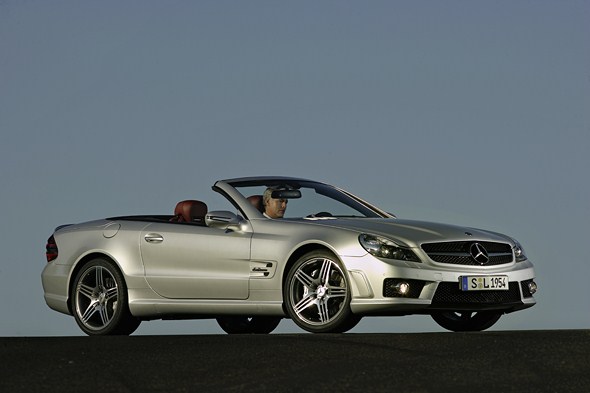
The first with eight cylinders: the 107 series (1971 to 1989)
A total of 237,287 open-top two-seaters produced in 18 years
· Engines again and again updated to reflect the state of the art
· Coupés of the SLC series available until 1981 parallel to the open-top version
In April 1971 a new SL rolled out onto the highway, the Mercedes-Benz 350 SL. For the first time in the history of the model series an eight-cylinder power plant did duty under the long bonnet.
From all sides it made the impression of a strong, self-confident, imposing open-top vehicle. Its fathers also gave it an equally well designed, removable coupé roof for the road.
Besides elegance and quality the body radiated safety, since the crash behaviour of the two-seater was far ahead of its time.
Difficult decision
The decision to manufacture the R 107 series (“R” as in Roadster instead of “W” as in Wagen = car) was taken by the Board of Management after intensive debates on 18 June 1968.
At dispute was whether there should be a Targa-roof version, i.e., one with a removable roof panel, instead of the fabric-topped variant, because owing to higher safety standards alarming news was to be heard from the USA regarding the licensing of open-top cars.
That a decision finally was made in favour of an open-top two-seater with a fabric roof and an additional removable hardtop can be attributed to Hans Scherenberg, the head of Development, who fought tooth and nail for it: “The SL gave me great pleasure, but also caused me great trouble.
This was no easy decision for us,” he summed up the decisive meeting.
The coupé question still was unanswered, however. It was not decided that day. Discussion centred around whether one should additionally, and soon, make a four-seater sports coupé based on the R 107 series, or wait for the coming S-Class (W 116) to build it on that basis.
But then a production model would not have arrived until much later, in the mid-1970s.
Karl Wilfert, then the head of Body Design in Sindelfingen, developed – pretty much on his own authority – a coupé based on the R 107 and presented it one day to the Board of Management as a “rough draft”. Rejected at first, Wilfert managed to push through his idea of a sports coupé with the tenacity which was so characteristic of him.
And so six months after its premiere the SL was followed in October 1971 by a comfortable four-seater Sports Coupé, the 350 SLC, whose unconventional lines also found it many friends around the world in the course of the years.
Internally the series was designated C 107. Up to the windscreen its appearance matches that of the open-top variant; behind the windscreen the overall height and length grows.
A flat roof spans the four-seater passenger compartment in a gentle curve, going over into a large and very steep rear window that arches in two directions. The boot lid is slightly convex in shape, unlike the SL’s.
In the side view the length of the Coupé is documented, firstly, by the 360 millimetre longer wheelbase (2820 millimetres versus 2460), secondly by the line of the side windows.
Without awkward B-pillars they are completely retractable, as is usual in a Mercedes-Benz Coupé. The SLC’s coefficient of drag is better than that of the SL so that the Coupé attains the same performance despite an added weight of some 50 kilograms.
A particularly noteworthy fact is that it fully lived up to its classification as a “Sports Coupé”, gaining wins for Mercedes-Benz in many rallies and long-distance races.
Safety as agenda
Béla Barényi’s safety concept with front and rear crumple zones and a rigid passenger cell found expression in the 107 series in a further developed form.
The backbone of the R 107 series is not simply a shortened and reinforced saloon floor assembly, as in the predecessor, but an independent frame-floor unit with a closed transmission tunnel and box-shaped cross and longitudinal members which featured differing sheet metal thicknesses and a resultant carefully defined crumple pattern.
The SL definitely had to be an open-top car, and that being the case the only protection in a possible roll-over would be provided by the A-pillar plus windscreen.
They were thoroughly redesigned and had 50 percent more strength to show than in the previously built version. In addition, to enhance its strength the windscreen was bonded into the frame.
This resulted in a remarkable power of resistance in the roof-drop test with the result that the open-top car could be licensed for the USA even without a Targa bar.
To complete the logic the rear window of the hardtop also was bonded into its frame.
Even in the interior there were pioneering changes to report. The hard dashboard made way for an ingenious sheet-steel design that yields on impact both in the top section and the knee area and is foam-padded.
The switches and levers were recessed. Another new feature: the four-spoke steering wheel based on the latest findings of accident researchers.
The proven impact absorber was still in place, but the steering-wheel rim, spokes, padded boss and hub were covered with polyurethane foam.
As further safety feature the fuel tank was no longer installed in the rear end but above the rear axle, protected against collision. From March 1980 the anti-lock braking system ABS was offered; from January 1982 also airbag and belt tensioner.
A bestseller right off the bat
But it was not the safety aspects that motivated customers around the world to quickly reach for the new SL. It was the promise of an open-top automobile – the only one offered in the USA over a period of several years – that was a successful piece of work in every respect.
Its distinctive front end with the dominant SL face, the wide-band headlamps and grooved indicator covers had a powerful aura; the lines of the low silhouette were harmonious – soft top open or closed, or with hardtop.
And the very slight inward curve of the boot lid, along with the concave hardtop, were reminiscent of “Pagoda” days. The wide-band tail lights with their ribbed surface not only were largely insensitive to soiling, but additionally gave the rear end a touch of vigour.
Extremely conducive to comfort and ease of operation was the easily and speedily operated soft top, a refined version of the “Pagoda” top. It took just 30 seconds to open or close it. Folded, it disappeared underneath a cover that was meanwhile customary in the SL series.
A number of details underscored the car’s safety aspirations. The seats were available from the start with head restraints, and seat belts also were included.
Physical well-being and driver-fitness safety were served by the heating system with its very spontaneous response, supported by new air ducting at the doors.
Newly developed wind-deflecting mouldings on the A-pillars, which also served to channel off mud-laden water in the rain, and dirt-repelling covers on the exterior mirrors enabled good visibility.
They kept the side windows clean even in inclement weather. The windscreen wipers arranged closely to each other in the centre of the car swept a respectable 70 percent of the windscreen area, were always optimally positioned in the flow of air and did not lift off even at higher speeds.
Engines with catalytic converter
During its 18-year “lifetime”, which was not planned to last that long, but in the end was indeed successful, this SL got a whole series of six- and eight-cylinder engines. Its model designations accordingly are quite varied.
The eight-cylinder models were led by the 350 SL (1971 to 1980), whose 3.5-litre engine (M 116) already was known from the W 108, W 109 and W 111 series.
The 147 kW which it delivered at 5800 rpm helped the SL, which did weigh 1600 kilograms after all, to clock nine seconds for 0 to 100 km/h and reach a top speed of 210 km/h. The 350 SLC had identical performance figures.
From autumn 1971 onwards the 450 SL also was produced. Its engine (M 117) developed an output of 165 kW at 5000 rpm. Top speed was 215 km/h, and it needed 8.8 seconds to go from 0 to 100 km/h.
In 1972 the corresponding Coupé version, the 450 SLC followed, with identical engine and identical performance. Prior to March 1973, both were destined exclusively for export to North America; after that they were included in the general sales range.
In July 1974 the SL model range was extended: as a consequence of the oil crisis of 1973, the SL and SLC now were available as models 280 SL and 280 SLC with the 2.8-litre M 110 engine.
It developed 136 kW at 6000 rpm and had proven its reliability in the two years before in the “Stroke Eight” series W 114/115 and in the W 116-series S-Class. Both models had identical performance: the top speed was 205 km/h; sprinting from 0 to 100 km/h in 10.1 seconds was possible.
So three SL engines now were available – nowadays nothing unusual, but in those days something new in the history of this model category.
Only the attentive observer could distinguish between the three variants: The 280 SL could be recognised by its narrower tyres in comparison to the 350 SL and the 450 SL.
In addition, the 450 SL featured an inconspicuous front spoiler which was attached to the rear lower end of the front apron and distinctly increased the radiator’s air throughput.
Between November 1975 and February 1976 the fuel injection systems of all three engines were changed for better compliance with the emission standards, which meanwhile also had become stiffer in most European countries.
The electronically controlled Bosch D-Jetronic was abandoned for the newly developed mechanically controlled Bosch K-Jetronic. The changeover entailed minor losses in performance in all three cases: in the 280 SL to 130 kW at 6000 rpm, in the 350 SL to 143 kW at 5500 rpm, and in the 450 SL to 160 kW at 5000 rpm.
At the same time the compression ratios of the 2.8 and 3.5-litre engines were slightly reduced. The 3.5 and 4.5-litre engines additionally got a contactless transistorised ignition and hydraulic valve play compensation to facilitate maintenance.
The compression ratio of the 2.8-litre unit was raised to the old figure again in April 1978. With a few supporting measures the engine then regained its earlier power potential of 136 kW, but now already at 5800 rpm.
In September 1977 Mercedes-Benz launched the 450 SLC 5.0 with a V8 engine (M 117) enlarged to a displacement of five litres.
A hidden innovation was the first-time application of hypereutectic cylinder contact surface machining, which made it unnecessary to insert cylinder liners.
The engine delivered 177 kW at 5000 rpm, good for zero to 100 km/h acceleration in 8.5 seconds and a top speed of 225 km/h.
The vehicle’s bonnet and boot lid were made of aluminium, and it had light-alloy wheels as standard. On the outside the 450 SLC 5.0 was recognisable by, among other things, a narrow spoiler on the rear end.
Revising the series
At the Geneva Motor Show in March 1980 the SL and SLC presented themselves in updated form. The interior appointments including steering wheel were matched to those of the 126-series S-Class, and the engineering was brought up to the same level.
The previous three-speed automatic transmission with torque converter was replaced with a four-speed variant. Models 280 SL and 280 SLC were given a five-speed manual transmission as basic equipment.
In addition, the hardtop now was included in the standard specifications of the open-top variant. But above all the light-alloy eight-cylinder engines of the 126-series S-Class, slightly modified, made their arrival in the 107 series. The six-cylinder engine of the 280 SLC remained unchanged.
The new 500 SL, equipped with the 5.0-litre V8 (M 117) familiar from the 450 SLC 5.0, replaced the 450 SL and made an output of 177 kW at 5000 rpm available, to give the new top-of-the-range model a 0 to 100 km/h acceleration of 7.8 seconds and a top speed of 225 km/h.
Models 350 SL and 350 SLC were sent off into retirement after nine years of production. Their successors were the 380 SL and 380 SLC, whose 3.8-litre light-alloy engine (M 116), with 160 kW at 5500 rpm, originated after the pattern of the five-litre unit, by enlarging the bore of the long-serving 3.5-litre V8 with grey cast iron cylinder block.
Both models attained top speeds of 215 km/h and needed nine seconds to go from 0 to 100 km/h.
From the outside the new models were almost indistinguishable from the previous models, except for the model plate. All three SL models now had a light-alloy bonnet and the discreet front spoiler familiar from the 450 SLC 5.0; the 500 SL also got a light-alloy boot lid with black plastic rear spoiler, already familiar from the five-litre Coupé.
In autumn 1981 both V8 engines were thoroughly redesigned in the context of the “Mercedes-Benz Energy Concept” to reduce their consumption and pollutant emissions.
Along with an increase in compression ratio the measures comprised camshafts with changed valve timing, air-bathed injection valves, and an electronic idling speed control.
Owing to the altered camshaft tuning the maximum torque could be shifted to a lower engine speed range and, in the case of the 3.8-litre engine, even increased.
This power plant underwent particularly far-reaching changes: to get a more favourable volume-to-surface ratio the bore was reduced and the stroke increased.
The modified 3.8-litre V8 thus had a slightly larger displacement. In both eight-cylinders, in exchange, so to speak, for the improved economy, minor losses in power had to be accepted, output dropping to 150 kW at 5250 rpm in the 380 SL and to 170 kW at 4750 rpm in the 500 SL.
As in the 126 series the final drive ratio was adjusted to the changed engine characteristics and made higher, from 3.27 to 2.47 in the 380 SL and from 2.72 to 2.24 in the 500 SL.
For the SLC Coupés these changes came too late, however: at the Frankfurt International Motor Show in September 1981, along with the “Mercedes-Benz Energy Concept” the 380 SEC and 500 SEC models of the C 126 series were presented, spelling retirement for the SLC models, which had been built for exactly ten years.
But even after ten years of production no thought was being given to a replacement for the SL models. Four years after the Energy Concept was presented, they even came in for extensive refinements, and so in September 1985, again at the Frankfurt show, a completely revised SL model range was introduced.
The emphasis was on a restructured engine range. A discreet facelift, primarily recognisable from the front spoiler and wheels with aluminium rims (diameter: 38.10 centimetres), was also part of the package.
The front axle was done over and the brakes enlarged with fixed callipers. To prevent the cars from pulling to one side during braking, the steering offset was reduced.
Comprehensive model refinement package
All engines were available in two versions: with a catalytic converter and slightly less output, and as so-called catalyst retrofit version without catalytic converter.
The catalyst retrofit versions could be fitted later on with a catalytic converter, for example when the widespread supply of unleaded petrol was ensured, and had their ignition system, electronics and cable harness prepared for this.
A newly designed 3.0-litre six-cylinder engine (M 103) which had made its first appearance in the 300 E of the mid-range series W 124 nine months earlier replaced the tried and tested 2.8-litre engine, as it had already done previously in the respective S-Class Saloon.
As a result the 280 SL was discontinued, and after a 22-year interruption there was again a sports car with the magic model designation 300 SL.
It delivered an output of 138 kW at 5700 rpm without catalytic converter (top speed: 203 km/h; 0 to 100 km/h in 9.6 seconds) and 132 kW with catalytic converter (200 km/h; 9.9 seconds).
A new edition to the range was the 420 SL with the 4.2-litre V8 engine (M 116), which at 5200 rpm delivered 160 kW without and 150 kW with catalytic converter.
It was created by adopting the bore of the original 3.8-litre engine and combining it with the stroke of the “post-Mercedes-Benz Energy Concept” 3.8-litre engine, and now replaced that unit in the SL, the S-Class Saloon and the SEC Coupé.
The 420 SL accelerated from 0 to 100 km/h in 8.5 seconds (with catalytic converter: 9 seconds) and attained a top speed of 213 km/h (205 km/h).
The 5.0-litre engine (M 117) also was modified; with catalytic converter operation in mind it now had an electronic ignition system and the electronically/mechanically controlled Bosch KE-Jetronic injection system and developed an output of 180 kW at 4750 rpm.
With catalytic converter the output was 164 kW at 4700 rpm. These values helped the 500 SL attain a top speed of 225 km/h (with catalytic converter: 215 km/h) and accelerate from 0 to 100 km/h in 7.3 seconds (7.8 seconds).
The most spectacular new development in the engine range was a 5.6-litre eight-cylinder (M 117), which was created by increasing the stroke of the 5.0-litre V8 and gave the SL an output of 170 kW at 4750 rpm.
The 560 SL was reserved to the export markets USA, Australia and Japan. Fitted with an emission control system in the US version it had a top speed of 223 km/h and sprinted from 0 to 100 km/h in 7.7 seconds.
Production of the R 107 series ended in August 1989, more than 18 years after the production start-up of the 350 SL. With that this SL series set an internal record that probably never will be broken: in the entire history of the company no other passenger car series has ever been produced over such a long period.
All told, in Sindelfingen 237,287 open-top cars were built, a number which impressively demonstrates the great popularity of the 107 series. Of the Coupé a total of 62,888 were built from 1971 to 1981.
The R 107 series in the press
In a first test of the Mercedes-Benz 350 SL auto motor und sport, Germany, No. 9, 1971, wrote: “Good suspension comfort, definitely up to saloon standard, proves to be an essential feature of the 350 SL: at low and high speeds it absorbs big bumps well and takes small bumps in a way that they never are a disturbance even on very poor roads.”
In 1986 Road & Track, USA, No. 11, 1986, compared the Mercedes-Benz 560 SL, which was in the last era of its production, with the Cadillac Allanté and summed up: “Legendary quality is Mercedes’ primary stock in trade. But brilliant performance and outstanding ABS braking have freshened it this year.
Against these attributes, Cadillac brings better handling and greater luxury to bear while failing to match Mercedes’ performance and quality.”
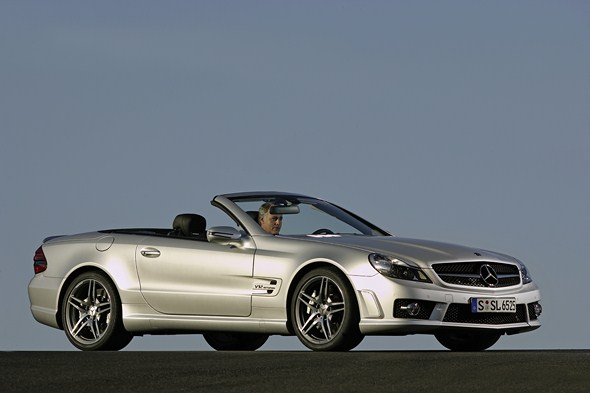
Technology car: the 129 series (1989 to 2001)
· Numerous innovations from the automatic roll-over bar to the integral seat
· Debut of the twelve-cylinder engine in the SL in the 129 series
· Official AMG versions available for the first time
At the 1989 Geneva Motor Show Mercedes-Benz presented an SL which was a new car in every respect. The first models were the 300 SL, 300 SL-24 and 500 SL. Internally the series was designated R 129.
Unlike the predecessors, its production did not take place in Sindelfingen, but in Bremen, for capacity reasons. Straightaway the response was extremely positive, and shortly after the presentation it was foreseeable that the planned annual production capacity of 20,000 units would be stretched to the limit for years and delivery periods of several years would have to be accepted.
The SL face has captured a permanent slot in the Mercedes-Benz model hierarchy over the decades. The new SL re-interpreted the traditional basic shape of the grille: within the radiator grille, organically integrated into the bonnet, the Mercedes star was complemented by horizontal strips made of anodised aluminium.
Chief designer Bruno Sacco had done an excellent job. The stylistically assured, no-frills lines of the slightly wedge-shaped body, the flared wheel arches for the wide-base tyres, the half-spoilers forward of the front wheels, a very slanted windscreen, the skilfully modelled rear end and the standard-fit light-alloy wheels produce an exceedingly harmonic overall effect.
The aerodynamic fine touches, including underbody and airflow through the engine compartment, added up to a fuel-saving, speed-increasing Cd of 0.32 with the hardtop mounted. A Cd figure of 0.40 was measured for the open-top car with closed side windows.
“Car Design Award”
Hardly a year after its launch the SL was decorated with the international Car Design Award. The SL was the top choice of an eleven-member jury of journalists from ten countries, assisted by a representative of the city of Turin and one from the Piedmont region.
The jury stated as reason for the award: “In the Mercedes-Benz 300 – 500 SL the ensemble of safety innovations …, exemplary ergonomic solutions, and stringent adherence to the traditional design culture of the manufacturer’s brand is convincing.
The new SL embodies the most valuable elements of up-to-date industrial design, without losing the flair that distinguishes every sports cabriolet.”
High torsional stiffness
The prerequisite for the proper operation of the fully automatic folding soft top under all conditions is the torsional stiffness of the body, which leaves nothing to be desired in this respect.
To reduce the vibration and torsion characteristics typical of open-top cars, additional diagonal struts are fitted in the particularly critical areas of the body. In the front end the front axle carrier is connected with the door sills by two specially shaped struts.
In the rear end two tubular struts between the door sills and the spare wheel recess serve the same function. Owing to these measures the torsional stiffness versus the previous model could be improved by around 30 percent and a saloon-like overall stiffness achieved.
New standards were set by this car also in the area of safety. The results of Mercedes-Benz’s rigorous frontal and rear-impact crash tests for the open-top vehicle were sensational and a clear proof of the scrupulous precision with which the developers had worked.
The resistance to side impact went far beyond what the law required and once again set trends for the sensible design of all details, for instance the overlapping of the doors with the sills, the cross-bracing beneath the seats, including the stiff sides of the transmission tunnel, or the high-strength steel tubes inside the A-pillars, which can withstand a roof impact.
This two-shelled structure of the front roof frame in conjunction with the bonding of the windscreen to the body results in very great stability even if a one-sided load is applied to the roof frame.
An integral part of the safety concept is the automatic roll-over bar which was realised in the SL for the first time in an automobile and has the purpose of protecting the occupants’ survival space in the event the car overturns.
So as not to impair open-top driving pleasure with a permanently installed, rigid rollbar, a flexible solution was realised which activates the roll-over protection only if needed.
When not in use the safety bar, consisting of a U-shaped high-strength steel tube foam-padded with polyurethane, is deposited in front of the soft-top compartment, closing off the rear compartment towards the back and forming a level surface with the top well lid.
When a roll-over threatens, the sensor-controlled roll-over bar is electromagnetically triggered, raised into position by the force of pre-compressed springs within 0.3 seconds and secured by pawls.
The high-strength centre pillars, connected over a large area with the rear longitudinal members, serve as basis for mounting and as support.
In addition to automatic triggering in an emergency, by means of a switch the driver can choose to raise and lower the bar slowly, with a hydraulic element carrying out the action.
Extremely sturdy integral seats
The most advanced feature of the interior design were the integral seats of the SL, which are a technical masterpiece in their design and an important part of the safety concept.
The seat frame and backrest are made of various special magnesium alloys executed in thin-wall casting technique. They incorporate the three-point seat belt with belt tensioner, the belt height adjustment, coupled with the head restraint adjustment, and electric stepper motors for adjusting reach, height and tilt of the seat cushion and backrest.
Another important feature is the automatic positive locking of the backrest. The resistance of the seat in a crash is many times higher than the possibly occurring forces.
Twenty patents for solutions to various details went into this seat; its creator received the Paul Pietsch Prize and high prize money in acknowledgement of his pioneering work in 1989.
Fully automatic folding soft top
The newly designed electro-hydraulic fabric top with which the SL is equipped as standard offers especially great operating convenience. Simply by operating a switch, within 30 seconds the soft top can be opened, folded and deposited in the narrow soft-top compartment, or taken out of the compartment and closed.
Simultaneously, the side windows and the roll-over bar are lowered and then returned to their starting positions. Up and closed, the top is taut and smooth in all directions – the vacuum that exists above the roof while on the go should not cause the top to balloon after all, and perfect operation of the roll-over bar under the closed soft top also must remain guaranteed.
The energy to operate the soft top is provided by an electrically driven hydraulic pump which is accommodated in the spare wheel recess together with the oil reservoir. The microprocessor-controlled motions are monitored with the aid of 17 limit switches, and the hydraulic system has 15 pressure cylinders and eleven solenoid valves.
The exemplary solutions include the draught-stop. Unlike the electro-hydraulic soft top it was not viewed as a high-tech marvel, but its development also involved attention to complex details.
The draught-stop consists of a framed, breathable screen which can be quickly attached to the roll-over bar and, when raised, appreciably enhances ride comfort when the soft top is open by minimising wind noise and draught.
With the draught-stop, leather jackets and caps for driver and front passenger are a thing of the past, as is tousled hair for the ladies.
Even high speeds cause no draught problems anymore, and open-top driving at low temperatures becomes a real show. Today the innovative draught-stop, for which the inventors hold four patents, is practically a taken-for-granted component of many convertibles around the world.
The standard-fit hardtop now was made of aluminium, and despite larger windows weighed 34 kilograms or about ten kilograms less than the coupé roof of the previous model.
As it is, uncompromising lightweight design and the extensive use of high-strength sheet steel had enabled realising a bodyshell weight of 405 kilograms, which was only 20 kilograms more than that of the previous model despite substantial improvements in structural safety.
Electrically operated windows and the electro-pneumatic central locking system, both standard equipment in all SL models, serve comfort and convenience.
The basic equipment of the 500 SL also included electric steering column adjustment for optimal adapting of reach, height and tilt to the driver.
A new suspension
The suspension conformed in principle to the familiar suspension design of the saloons of series 201 and 124.
The new SL models thus had a coil-spring shock absorber strut independent front suspension with anti-dive control and wishbones, gas-filled shock absorbers and stabiliser, and a modified multi-link independent rear suspension with anti-squat and anti-dive control, coil springs, gas-filled shock absorbers and stabiliser.
This guarantees excellent handling characteristics. Many components were adapted to the altered installation conditions and stresses and loads in the SL; the axle geometry also was matched to the special demands on the driving characteristics and comfort.
As an optional extra a newly developed auxiliary system also was available that represented the most advanced suspension technology realisable at the time and combined three subsystems with each other.
The purpose of this level adjustment and regulation on front and rear axle was to maintain an always constant vehicle level with the engine running.
The automatic speed-dependent level adjustment function lowers or raises the vehicle level depending on the actual speed; for driving on poor roads the level can be increased by 30 millimetres; at a speed of more than 72 km/h the normal level first can be set, and from a speed of more than 122 km/h then lowered by 15 millimetres.
The third component, the Adaptive Damping System ADS, used adjustable shock absorbers and a complex electronic control to adapt the damping fully automatically, as needed, and within fractions of a second, to the driving state determined by five sensors.
All in all the sprung mass vibrations are reduced depending on vehicle load, road condition and style of driving. This was virtually a preliminary stage of the active suspension which was developed to production standard in 1999 in the C 215-series Coupé.
In keeping with their sports credentials, all models of the R 129 series were fitted as standard with 15-hole light-alloy wheels (diameter: 40.64 centimetres) and wide-base tyres size 225/55 ZR 16.
The larger wheels compared with the previous models permitted installing large brakes appropriate to the improved performance of the SL. New were the front fixed-calliper disc brakes featuring four pistons, two pairs with different diameters.
This design, used for the first time in a Mercedes-Benz passenger car, ensures even brake pad wear and better utilisation of the pad volume.
The front and rear disc brakes are internally ventilated. The anti-lock braking system ABS was part of the standard configuration of all three models.
From September 1995 on the Electronic Stability Program ESP® was available for the SL 500 as an optional extra. It was standard equipment for the SL 600.
From December 1996 on the six-cylinder models also could be fitted with ESP® if they were ordered with the electronically controlled automatic transmission available from June 1996.
Another world first serving active safety also saw use at this time: the Brake Assist BAS, installed as standard from December 1996 in all models of the 129 and 140 series. BAS is able to detect emergency braking and, if need be, automatically build up the maximum brake boosting effect in shorter time than before.
This distinctly reduces the braking distance of the vehicle. In early April 1998 the Electronic Stability Program ESP® was included in the standard equipment of the SL 500 and SL 60 AMG; in August 1999 it also became a standard feature in the two six-cylinder models, SL 280 and SL 320.
The first facelift
Visually and technically updated SL models were presented at the Frankfurt International Motor Show in September 1995. The facelifted variants were distinguished by a modified body design, more extensive standard equipment, and more refined engineering.
The body design modifications were of a minor nature and ranged from redesigned front and rear bumpers, colourless glass covers for the front directional indicators, and a subtle change in the radiator grille, which now had six slats.
The side skirts, like the bumpers, no longer were painted in a contrasting colour, but in the colour of the car, and had modified breathers, a prominent feature serving to identify the facelifted models.
Other new items were the bichromatic tail lights with their uniform red appearance, and 12-hole light-alloy wheels, the standard for all SL models.
As an optional extra a glass roof with sunblind was available; it could be fitted in place of the usual aluminium hardtop. In the interior, the door trim, steering wheel and seat design were modified.
Headlamps with xenon gas discharge lamps first introduced a few months earlier in the 210-series E-Class now also were available in the SL.
Compared with conventional halogen headlamps the new xenon lamps were twice as intense and ensured better, brighter illumination of the roadway. Dynamic headlamp range adjustment prevents dazzling oncoming traffic.
A world first was introduced simultaneously in the SL-Class and S-Class. As first carmaker Mercedes-Benz was able to present an improved cruise control which could regulate the speed down to 30 km/h; the updated SL models were fitted with this function as standard.
The second facelift
In 1998 the second facelift followed. But it involved only a few modifications to the design of the SL: purpose of the discreet stylistic touch-ups was to give the sports car an even more dynamic look.
This was achieved with a slightly changed rear end in which the now monochromatic glass covers of the tail lights presented themselves in a gentler look with only three ribs.
A new oval tailpipe trim for the exhaust system including adjustments on the bumper emphasised the sporty appearance. A round shape also was the dominant feature of the new exterior mirrors, which were adapted to the design of the SLK and were the most important external identifier of the facelifted models.
The door handles and detachable body parts of the facelifted SL models had a high-gloss finish in the colour of the car. The size and design of the wheels also were modified: the SL models now had newly designed five-hole light-alloy wheels and size 245/45 ZR 17 tyres as standard.
Proven engine technology right from the start
All three engines of the original SL portfolio in the R 129 series feature a closed-loop catalytic emission control system as standard.
The entry-level engine was the two-valve-per-cylinder six-cylinder engine (M 103) in the 300 SL (1989 to 1993) with an output of 140 kW.
It had already served well in the saloons of the 124 and 126 series, but was revised for use in the SL. The most important improvements were a redesigned combustion chamber, which reduced the emissions of unburned hydrocarbons, and a modified emission control system.
By eliminating the close-coupled primary catalytic converter, which was subject to high thermal stresses, and enlarging the cross-section of the exhaust pipes and the now two-pipe catalytic converter it was possible raise the rated output of the engine from 132 kW to 140 kW.
The top speed was 228 km/h; 9.3 seconds was the figure stated for 0 to 100 km/h acceleration.
From 1989 to 1993 there was also the 300 SL-24 model featuring a newly designed four-valve-per-cylinder six-cylinder engine (M 104).
This engine is based on the M 103, and its parts are mostly identical with those of the two-valve counterpart. New were the four-valve cylinder head and map-controlled electronic intake camshaft adjustment, used for the first time at Mercedes-Benz.
In conjunction with a higher compression ratio and an electronic ignition system with anti-knock control, the result was a 29 kW increase in output over the M 103 to 170 W.
The performance of the 300 SL-24 was thus noticeably sportier despite almost identical fuel consumption (top speed: 240 km/h, 0 to 100: 8.4 seconds), but had to be bought at an additional cost of almost DM 10,000.
The successors to these two models in the years 1993 to 1998 were the SL 280 (2.8 litres displacement, 142 kW) and SL 320 (3.2 litres displacement, 170 kW), both with four-valve-per-cylinder six-cylinder engines from the M 104 series.
The car that attracted particular attention at the 1989 Geneva Motor Show was the 500 SL, which as top-of-the-range model had a 240 kW 5.0-litre four-valve-per-cylinder V8 engine (M 119), making it the most powerful Mercedes-Benz production car at the time.
The design of this engine was based on the 5.0-litre M 117 light-alloy engine, which had stood the test of over ten years’ time. Crankcase, crankshaft and connecting rods were extensively modified to obtain the higher output figures.
The two four-valve cylinder heads were of new design and had adjustable intake camshafts like the four-valve-per-cylinder six-cylinder.
Decisive for the marked increase in output (plus 60 kW), along with conversion to the four-valve-per-cylinder technology, were the anti-knock control, a new two-box air filter with reduced suction resistance, and, not least of all, changes in the emission control system: like the two six-cylinder units the four-valve V8 had no more primary catalytic converter, and a two-pipe catalytic converter with a larger cross-section.
This power potential gave the 500 SL impressive performance to outclass its predecessor: from a standing start the top-of-the-range model sped from 0 to 100 km/h in 6.2 seconds; the top speed was electronically limited to 250 km/h.
In autumn 1992, when the 600 SL appeared, the engine of the 500 SL was slightly revised. The version of the four-valve V8 with Bosch KE-Jetronic used previously was replaced by the “standard-deck engine” which was already being used in the 500 E (W 124) and in the Saloons and Coupés of the S-Class (140 series).
Characteristic features of the new engine were the modified crankcase, whose deck height was now identical with that of the 4.2-litre unit, and the electronic injection system Bosch LH-Jetronic with mass air flow sensor.
As in the V12 engine, full load enrichment was dispensed with here to reduce the pollutant emissions – a measure affecting not only the SL, but all other car models with V12 and V8 engines too.
In the case of the 5.0-litre engine this meant the loss of 4.4 kW output (now 235 kW). But for all practical purposes this hardly made itself felt in the performance.
From June 1993 onwards the 500 SL was called the SL 500 owing to a reform of the nomenclature; this reversal of the model designations applied as a matter of principle to all Mercedes-Benz models.
The twelve-cylinder arrives
In October 1992 the dream of many a friend of the SL came true: three-and-a-half years after the presentation of the R 129 series, it too was now available with the 6.0-litre V12 engine, which had already proved itself in the saloons and coupés of the 140-series S-Class.
To further reduce pollutant emissions the injection system was modified and full-load mixture enrichment dispensed with. In the 600 SL, known from June 1993 as the SL 600 and, all told, available from 1992 until 2001, the most powerful engine in the passenger car sales range mobilised 290 kW and made brilliant performance possible: at 6.1 seconds the acceleration was slightly better than that of the 500 SL; the top speed likewise was governed at 250 km/h.
The twelve-cylinder was a model of smoothness and turbine-like power delivery.
Above all, its imperturbability in high speed regions and the impressive and simultaneously refined manner in which it reached top speed characterised the 600 SL.
The large extra charge of more than DM 60,000 compared with the 500 SL made its ownership a matter of prestige. But for that the new top model of the series was fitted as standard with a whole range of extras that only could be had at an additional charge in the 500 SL.
Apart from the Adaptive Damping System ADS with level control on the front and rear axle the basic equipment comprised, for example, cruise control, automatically dimming interior mirror, headlamp cleaning system, automatic climate control, leather appointments and seat heating.
Externally, only the model plate and two “V12” emblems in the vicinity of the air outlets behind the front wheel cut-outs distinguished the 600 SL from its sister models.
The 1995 facelift brought improvements to the engines and transmissions of the SL 500 and SL 600 models. From September 1995, both featured a five-speed automatic transmission with torque converter lockup clutch, a completely new development that replaced the previous hydraulically controlled transmission.
The heart of this technical wonder was an electronic transmission control that quickly and automatically adapted shifting behaviour to every driving situation and permanently exchanged data with the electronic engine management.
Apart from these forward-looking innovations the automatic transmission was appreciably more compact and lighter than comparable five-speed units. The engines were revised once more to cut fuel consumption and pollutant emissions further.
For this purpose the 5.0-litre V8 engine got a modified crankshaft, optimised valve timing, lighter pistons, individual ignition coils for each cylinder as well as an improved electronic engine management system called Motronic ME 1.0.
Fewer changes were made to the design of the V12 power plant and merely concerned the configuration of the ignition coils and the electronic engine management.
As a result of the various modifications to the engine and the use of the new automatic transmission, the fuel consumption of the SL 500 and SL 600 could be reduced by ten percent with output remaining unchanged.
From June 1996 the new electronically controlled automatic transmission also was available for the six-cylinder models SL 280 and SL 320 – as an optional extra for the 2.8-litre variant, as standard equipment for the SL 320.
V-engines instead of in-line engines
The 1998 facelift ushered in the V-engine generation with six and eight cylinders, which took the place of the six-cylinders of the M 104 series and the V8 unit of series M 119 also in the SL.
The engines featured three-valve-per-cylinder technology and dual ignition for better emission values. They also excelled in lower cost of production.
Outputs ranged from 150 kW in the SL 280 (M 112, top speed 232 km/h, 0 to 100 km/h in 9.5 seconds) to 165 kW in the SL 320 (M 112, 238 km/h, 8.4 seconds) to 225 kW in the SL 500 (M 113, 250 km/h, 6.5 seconds).
The top-of-the-range SL 600 continued to use the tried-and-tested twelve-cylinder engine (M 120) with 290 kW. The SL 280 was now the sole model of the series still available with a five-speed manual transmission, all sister models had automatic transmission as standard.
Mercedes-AMG GmbH
Anyone still not satisfied with the output and prestige afforded by the eight-and twelve-cylinders could turn to AMG in Affalterbach, not far from Stuttgart.
Since 1990 a cooperation agreement existed between AMG and Daimler-Benz AG. Effective 1 January 1999 AMG then became a 51-percent subsidiary of the then DaimlerChrysler AG and took the name Mercedes-AMG GmbH.
AMG offers power-hungry customers several alternatives. When the first vehicles developed on the basis of the cooperation agreement came out on the market in 1993, the first SL model was the SL 60 AMG (M 119, 6.0-litre V8, 280 kW), which was sold until 1998; a purely AMG version with the same engine had existed earlier, from 1991 to 1993, under the name AMG 500 SL 6.0.
Models SL 55 AMG (M 113, 5.5-litre V8, 260 kW, 1999 to 2001) and the top-of-the-range model with twelve-cylinder engine, the SL 73 AMG (M 120, 7.3-litre V12, 386 kW, 1999 to 2001), followed.
The latter’s maximum torque of enormous 750 Newton metres propelled the vehicle from 0 to 100 km/h in just 4.8 seconds.
The top speed of both cars was electronically limited to 250 km/h, but the limit could be neutralised on customer request.
All power transmission components of the AMG models, from automatic transmission to rear axle, were adapted to the higher loads.
The AMG bodystyling package with integral fog lamps in the bumper emphasises the tense dynamics of the sports car even more, without laying hand on the clear lines of its design.
The large AMG light-alloy wheels (diameter: 45.72 centimetres) added a further dash of unmistakable sportiness to the looks.
The special models of the R 129 series
Special SL models became available for the first time in the R 129 series. Extended and modified appointments distinguished them from the series-produced cars.
This made them exclusive, offered a price advantage, and simultaneously boosted SL sales. Between 1995 and 2001 there were 17 special series built in differing numbers, from ten to 1515 units.
In 1995 the “Special Edition” with a production run of 630 units debuted. It was available as SL 280, SL 320 and SL 500. The distinguishing features included an exterior finished in brilliant silver, combined with red soft-top fabric.
In the same year the special series “Mille Miglia” was released. It served as VIP and escort vehicle at the Mille Miglia Storica in Italy.
There were ten Mille Miglia units in all based on the Special Edition, but with further distinctive features such as an unobtrusive black-and-white chequered flag on the ornamental grilles of the front wings.
In 1998 another “Special Edition” arrived, available for all models except the SL 60 AMG; 500 units were built. Obsidian black was chosen as exterior paint finish; the leather seats were in designo red with black topstitching.
The SL 280 was given the five-speed automatic transmission as standard equipment.
A further small VIP series was released on the occasion of the 1999 Mille Miglia Storica. It was based on the SL 55 AMG and ten units were built.
One year later the “SL Edition” stimulated the brand’s sports car sales; 708 units were built – the third-highest volume for an R 129 SL special series, and available as SL 320 and SL 500. The “Final Edition”, also dating from 2000 – 674 units were produced (all models with the exception of the SL 55 AMG and SL 73 AMG) – already heralded the approaching discontinuation of the series.
Special VIP models again were available that year: the “Formula One Edition” (20 units) based on the SL 500 on the occasion of the Indianapolis Formula One race, and twelve units of the “Mille Miglia” of 2000. In 2001 the last special “Mille Miglia” model in the R 129 series followed, with thirteen units built this time based on the SL 600.
Various special series were created upon the request of individual markets, for instance the “40th Anniversary Roadster Edition” (USA, 1997, 750 units of models SL 320 and SL 500 and 35 AMG SL 60 Limited Edition models), in celebration of the coming of the Mercedes-Benz 300 SL Roadster in 1957; “designo MB UK” (England, 1998, 150 units), “designo MB Japan” (Japan, 1998, 67 units), “designo Vintage Edition UK” (England, 2000, 49 units, models SL 280 and SL 320), “designo Heritage Edition UK” (England, 2000, 49 units, models SL 280 and SL 320), “Silver Arrow Edition USA” (USA, 2001, 1515 units of model SL 500, 100 units of model SL 600) and “Silver Arrow Edition UK” (England, 2001, 100 vehicles, 500 SL model).
The successor arrives
In July 2001 the Mercedes-Benz SL 500, the first model of the new SL series, the R 230 series, had its world premiere. In the same month the last of a grand total of 204,940 units of the R 129 series rolled off the assembly line at the Bremen plant.
In terms of overall volume the first SL manufactured in Bremen was not quite as successful as its predecessor from the R 107 series (237,287 units); but if average annual production is compared, the R 129 series with some 16,500 units takes a very clear lead.
The most successful model of this series was the five-litre variant equipped with the four-valve V8 engine M 119, of which a total of 79,827 were produced from 1988 to 1998.
The rarest variant by far is the SL 280 with V6 engine, which served as entry-level model for the series from 1997 and rolled off the assembly line only 1704 times.
The R 129 series in the press
Shortly after the premiere of the Mercedes-Benz SL 500 auto motor und sport, Germany, No. 16, 1989, wrote: “Altogether the new SL cannot be topped for passive safety by any sports car.
Apart from the ingenious body structure and the optionally available driver and front passenger airbags, the automatically extended roll-over bar dispels fear of roll-overs – though a little concern remains, of course, because auto motor und sport did not confront the function with the worst case.”
The American motor magazine Road & Track, No. 3, 1993, tested the twelve-cylinder model Mercedes-Benz 600 SL: “Drive the 600 SL, however, and the change is dramatic.
Although the 500 SL provides everything we expect from a Mercedes (a 0-60-mph time of 6.4 seconds, fine handling and safety), the V-12 just adds another dimension to this luxury sports car. Some of that is pure power.
Time to 60 mph – by our watch – drops another 0.4 sec., but what impresses most is all that torque lying in wait when you kick the 4-speed down a gear or two.
Add the matter of smoothness – the smoothness of power that builds strongly rather than erupts, and the aural smoothness of the engine’s hum in the background, even at full throttle.”
In a test report auto motor und sport, Germany, No. 16, 1998, wrote about the Mercedes-Benz SL 500: “For nine years the
Mercedes SL 500 has embodied a highly cultivated blend of performance, safety and comfort.
The standard-fit automatic transmission and the perfected coexistence of two roofs are a part of this philosophy.”
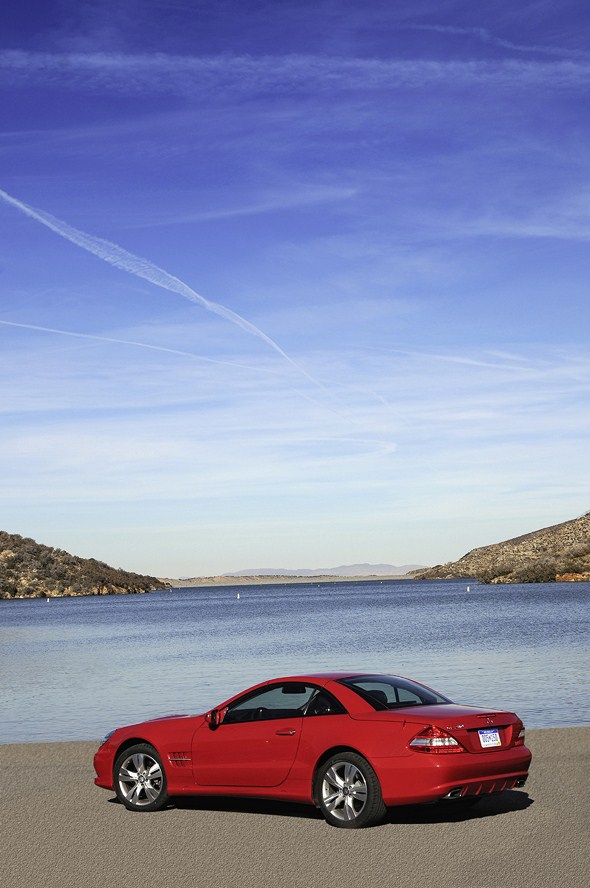
With vario-roof: the R 230 series (from 2001)
· Open-top car and coupé in one – the roof folds in 16 seconds
· Equipped with advanced dynamic handling systems
· Lightweight body with a large share of aluminium
The next SL was presented to the press in July 2001 at Deichtorhallen in Hamburg. Owing to a combination of advanced electronic chassis systems which was unique in the world at the time, the R 230-series SL offered an outstanding driving experience coupled with highest levels of operating safety and so set trends for sports cars and car manufacture in general.
At market launch, the first model available was the Mercedes-Benz SL 500 with an output of 225 kW. In autumn 2001 it was joined by the SL 55 AMG with a supercharged V8 engine and 350 kW. In 2002 the SL 350 featuring a 180 kW 3.7-litre V6 engine followed, and in January 2003 finally Mercedes-Benz introduced the SL 600 with the powerful 368 kW 5.5-litre V12 biturbo engine as new flagship model.
The comprehensive standard equipment of the SL included, for example, leather-upholstered integral seats plus memory function for the electric seat and steering wheel adjustment (additionally stored in the electronic ignition key); multifunction steering wheel, automatic climate control and stereo car radio.
As optional extras, innovative assistance systems like the DISTRONIC proximity control, the automatic emergency call system TELEAID, the control and display system COMAND or the electronic tyre pressure monitoring system were available.
Leather, fine wood and aluminium are the materials used to ensure the typical exclusivity and perceived value of the SL.
There was a choice of two types of leather, four high-quality trim variants and five appointment colours. Matt-finished chrome framed the four individual, classic chronometer-style instruments in the cockpit and also could be found in other details of the interior.
The design unites tradition and future
The design of the R 230 series blends tradition and future through distinctive details. For instance, the air intakes in the front wings take up a typical feature of the 300 SL from the 1950s.
The thin, wing-like segments on these side air intakes – called fins by experts – also are a reminiscence. The designers use this stylistic element additionally to give a sporty touch to the grilles of the openings on the bonnet.
The horizontally stretched radiator grille has always been an unmistakable feature of the SL. The R 230 took up this tradition, but showed it in an up-to-date interpretation, thrusting a louvred radiator grille with a flatter slope than previously into the wind.
This made the front end, in combination with the more pronounced wedge shape of the body, appear very dynamic and powerful. The four louvres encompassed the Mercedes star, which in its accustomed size and position clearly indicates the brand to which the two-seater belongs.
These typical SL features harmonised with the new elements, the headlamps, for example: on each side two of the familiar four “eyes” merge into one without giving up their basic oval shape.
The up-to-date clear-lens look effectively enhanced the standard-fit bi-xenon headlamps and gave an additional pinch of brilliance to the front design.
The long bonnet took up the curves of the headlamps and carried them towards the rear in a tense arch. The design of the seemingly muscular wings also evolves from this ensemble.
The soft lines of the bonnet and wings merge smoothly into the taut lines that give structure to the sides of the body at the shoulderline.
Another line develops in the lower part of the wings from the verve generated by the side air intakes. It gives a formal hold to the large, quiescent surfaces of the doors and creates a visual bond with the rear end.
The steeply raked windscreen emphasises the sports car character and accentuates the low, wedge-shaped silhouette.
16 seconds of roof acrobatics.
Unlike its predecessors the R 230-series SL always carries its hardtop with it. The integration of the SL’s vario-roof into the car’s flowing lines is proof of the car’s high design quality.
At the push of a button, or via remote control, the roof can be opened or closed within 16 seconds. An extremely complex swivelling mechanism ensures that the three roof components disappear into the upper part of the boot in a space-saving way.
Underneath it, 235 litres of luggage space are available. With the top up, the vehicle offers 317 litres of space, inclusive of the luggage holder in the spare wheel recess – 52 litres more than the previous model. Since mid-2002 a glass roof variant is also available.
Further features underscored the impression of dynamism and elegance created by the R 230 series, for example the body with the powerfully shaped front apron, the muscular curves and the pronounced wedge shape, but also stylistic elements like the distinctive outline of the side skirts, the wide wheels (diameter: 43.18 centimetres) or the oval tailpipes of the exhaust system.
All body parts – from door handle to bumper –were painted the colour of the car so that from a formal viewpoint and colourwise the sports car appears all of a piece.
This also applied to the rear end, characterised by large, triangularly shaped tail lights. Here again there was no play of colours, but elegant consistency: the tail light lenses were coloured a uniform red – special filters in front of the reflectors ensured that the indicators still appeared yellow and the reversing light white.
Sensotronic Brake Control SBC™
The technical innovations of the R 230 series include the electrohydraulic braking system Sensotronic Brake Control SBC™, which had its premiere in this series.
It operates in conjunction with the Electronic Stability Program ESP® and the active suspension system Active Body Control ABC, which minimises body movements or any tendency to skid during cornering and braking.
Sensotronic Brake Control SBC™ also was a gateway to the world of future “by wire” systems that no longer transmit the driver’s commands mechanically or hydraulically, but electronically – by cable.
The most important performance characteristics of SBC™ include extremely dynamic brake pressure build-up and a reliable “feel” for driver and vehicle behaviour owing to sophisticated sensor technology.
For example, the system diagnoses a rapid shifting of the driver’s foot from the accelerator to the brake pedal as evidence of an emergency situation, automatically increases the pressure in the brake lines and simultaneously positions the brake pads on the brake discs so that they can grab the disc without delay and with full force when the driver depresses the brake pedal.
The effect is that the stopping distance is three percent shorter in an emergency stop.
In addition, thanks to variable brake force distribution SBC™ affords more safety when braking on bends or on difficult surfaces, depending on wheel contact force and slip. Owing to greater dynamics and precision SBC™ also enhances the performance of the Brake Assist BAS and the Electronic Stability Program ESP®.
This package of highly efficient electronic control systems initiated a revolutionary trend in automobile manufacture in the area of chassis, handling safety and driving dynamics.
Suspension with Active Body Control ABC
These systems are supported by wheel suspensions which react sensitively in conjunction with the Active Body Control ABC. At the front a state-of-the-art four-link system ensures optimal road roar and tyre vibration characteristics, precise wheel location and steering.
The lower elements of the front axle, the steering gear of the rack-and-pinion steering, and the engine mounts are connected with an aluminium frame-type integral support which also celebrated its premiere in the new SL.
In the SL of the R 230 series the multi-link independent rear suspension, still unsurpassed for wheel location, is made entirely of aluminium for the first time, including wheel carriers and subframe. To improve the oversteer/understeer characteristics even more, the axle geometry was modified in detail.
Safety redefined
Ever since the “Pagoda” the abbreviation SL is synonymous with pioneering achievements in the areas of active and passive safety in open-top sports cars.
With an entirely new, comprehensive concept the R 230-series SL clearly outstrips the previous safety standards to make it a model in the area of vehicle safety in particular for sports cars.
The concept makes allowance for all aspects of active and passive vehicle safety – from accident avoidance with the aid of electronic handling dynamics systems like SBC™, Active Body Control ABC, Brake Assist BAS, acceleration skid control ASR or ESP®, to the structural integrity of the body with a high level of passenger cell rigidity in every conceivable type of accident.
Some of the things contributing to occupant protection together with the high-strength body structure: two-stage airbags for driver and front passenger, new head/thorax bags in the doors, newly developed integral seats, high-performance belt tensioners, belt force limiters, or the sensor-controlled roll-over bar, which goes into action even when the vario-roof is closed.
In the event of an accident the automatic emergency call system TELEAID (optional extra) developed by Mercedes-Benz ensures that emergency doctor and police are automatically alarmed and guided to the accident scene by satellite navigation.
Safety development between rating tests and reality.
The R 230 SL series has passed the most rigorous crash tests such as an offset frontal impact at 64 km/h or the 90-degree side collision at 50 km/h, both of which are included in the European NCAP (New Car Assessment Programme) procedure and which make highest demands of the vehicle structure especially in the case of open-top cars.
The engineers have devoted just as much attention to the aspect of ease of repair, which they investigate in frontal and rear impacts at a collision speed of 15 km/h in each case. The body structure of the SL affords greatest possible safety to occupants and meets the objective of reasonably priced repair.
In a frontal or rear collision at speeds above 15 km/h the bodyshell structure of the SL provides an exemplary high level of occupant protection owing to many innovative details.
Around 33 percent of the bodyshell is made of high-strength sheet affording maximum resistance despite minimum material thickness. All components crucial to crash safety and body stiffness are made from high-strength steel sheet. The fuel tank is made of sheet steel and is located in a protected position above the rear axle.
Fuel economy a high priority
Fuel economy in the R 230-series SL is a topic which runs like a thread through many chapters of the design specifications.
The lightweight body plays a decisive role in achieving a favourable fuel economy in all variants: bonnet, front wings, doors, boot lid, tank partition and other components consist of aluminium; especially the 1.40 metre long bonnet is a remarkable lightweight component.
The well-thought-out aerodynamics of the smooth body including underbody, designed to reduce drag, helps to save fuel as well as to minimise noise.
The coefficient of drag of 0.29 for the closed car is considered a very remarkable figure; in the previous R 129 it was still 0.32 with hardtop. The open-top SL of the R 230 series has a Cd of only 0.34 (R 129: Cd = 0.40 with side windows closed).
Debut with the SL 500
In summer 2001 the SL 500 debuted first, featuring a 5-litre V8 engine (M 113) delivering 225 kW and torque of 460 Newton metres. It was one of the most powerful engines of its segment, did clearly better than the stringent EU 4 emission standards required, and accelerated the SL 500 from 0 to 100 km/ in 6.3 seconds.
The top speed was 250 km/h (electronically governed). The proven five-speed automatic transmission with electronic control, two shift programs and torque converter lockup clutch were standard equipment in the SL 500. A newly developed Touchshift permitted very fast manual gear-changing.
In September 2001 the SL 55 AMG premiered at the Frankfurt International Motor Show. Equipped with a new V8 supercharged engine, it was the most powerful Mercedes-Benz passenger car at the time.
The 5.5-litre power plant (M 113) developed 350 kW and delivered a maximum, constant torque of 700 Newton metres from 2650 rpm to 4500 rpm.
The car spurted from 0 to 100 km/h in 4.7 seconds; the electronically limited top speed was 250 km/h. The engine was combined with a five-speed automatic transmission including shift buttons on the steering wheel.
The AMG version was distinguishable on the outside from the SL 500 among other things by bumpers with an even more powerful styling, distinctively shaped side skirts, dark-tinted tail lights, exclusive multi-spoke wheels (diameter: 45.72 centimetres) and four chrome-plated exhaust pipes.
In the interior, the more firmly upholstered integral seats with a special perforation and coloured topstitching, high-quality aluminium trim elements with a sand-cast look, and cockpit instruments with light dials, silver-coloured symbol disks and red needles emphasised the character of this sports car.
In 2002 came the SL 350 with a 180 kW 3.7-litre V6 engine (M 112). It accelerated the car in 7.2 seconds from 0 to 100 km/h and gave it an electronically limited top speed of 250 km/h.
The standard transmission was the SEQUENTRONIC automated six-speed manual transmission operated via two shift paddles on the steering wheel. The electronically controlled five-speed automatic transmission with Touchshift was available as an optional extra.
A V12 engine in the flagship model
In January 2003 Mercedes-Benz presented the SL 600 with 368 kW 5.5-litre V12 biturbo engine (M 275) as new flagship of the series.
It produced tremendous 800 Newton metres of torque, already available at 1800 rpm and constant up to 3600 rpm. The newly developed Mercedes-Benz twelve-cylinder engine with two turbochargers and air-to-water intercooler, three-valve-per-cylinder technology, alternating-current twin-spark ignition and other high-tech innovations is one of the most advanced passenger car engines in the world.
It affords effortless superiority in any driving situation. The SL 600 needed only 4.7 seconds to go from 0 to 100 km/h. The top speed was electronically limited to 250 km/h.
From the outside the SL 600 can be recognised by a radiator grille with discreet chrome inlays, silver-painted brake callipers, V12 emblems on the side air intakes, bi-xenon headlamps and exclusive light-alloy wheels. The front wheels have tyres of size 255/40 R 18, the rear wheels tyres of size 285/35 R 18.
Only twelve units: SL 350 “Mille Miglia Edition 2003”
Based on the SL 350, in June 2003 Mercedes-Benz presented the special model “Mille Miglia Edition 2003” to commemorate the legendary road race. Only twelve were built.
They were painted in a special “Silver Arrow” metallic finish and had matt-finished aluminium shoulderline trim strips, beautifully designed light-alloy wheels (diameter: 45.72 centimetres), wide-base tyres of size 255/40 ZR 18 (front) and 285/35 ZR 18 (rear) and “Mille Miglia” badges in the air outlet grilles of the front wings and on the boot lid.
The vario-roof of the special model was made of glass and gave the passengers a panoramic view. The special features in the interior included two-tone nappa leather appointments: the seats were in “classic red”, an accent colour already used in the legendary SL sports cars of the 1950s.
The roof was lined with soft Alcantara, and the trim elements on the centre console and the doors were aluminium with a matt-finished surface. With the aid of a new laser technique the designers worked the “Mille Miglia” logo and even the course of the thousand-mile race into the leather covers of the head restraints.
Other standard equipment items on the special model included the control and display system COMAND, the parking assist PARKTRONIC, multicontour backrests, CD changer and sound system. The V6 engine of the special model was combined with a five-speed automatic transmission as standard.
A special model on the 50th birthday
In 2004 Mercedes-Benz celebrated the appearance of the 300 SL in 1954 with the special model “Edition 50”, available as SL 350 and SL 500 in a series limited to a total of 550 units.
The visual highlights included a matt silver-painted radiator grille with chrome trim strips, light-alloy wheels (diameter: 45.72 centimetres) in turbine design, shoulderline trim strips in a high-sheen finish, a draught-stop frame with high-sheen finish or the darkened tail lights.
In the interior, the instrument cluster was trimmed with a leather/Alcantara combination. The seats, luxury climatised seats with multicontour function as standard, had nappa leather covers; the head restraints showed a lasered “Edition 50” logo.
The trim elements in the interior were made of a decorative new aluminium material or, alternatively, black ash wood. Depending on personal taste, if desired the leather appointments also could be had in two-tone condor silver/black or single-tone designo black with topstitching in quartz.
A comprehensive range of standard equipment was included: for example, the radio/navigation system COMAND APS with CD changer and surround sound system, but also bi-xenon headlamps with headlamp cleaning system and PARKTRONIC.
2006: facelift for the R 230 series
Five years after launch, Mercedes-Benz upgraded the SL. The 2006 Geneva Motor Show was chosen as debut event. In particular the engines, drive system and suspension were given a sportier tuning.
The V8 engine (M 273) of the SL 500 is a new design; it now has a displacement of 5.5 litres and develops an output of 285 kW. The 0 to 100 km/h acceleration is 5.4 seconds. In the USA the vehicle is sold as the SL 550.
The six-cylinder engine of the SL 350 also is a new development. The 200 kW V6 power plant (M 272) delivers about eleven percent more output while enabling fuel savings of more than one litre per 100 kilometres.
The combined NEDC consumption is 10.3 litres per 100 kilometres. The SL 350 accelerates from 0 to 100 km/h in 6.6 seconds and is thus over half a second faster than the previous model.
At the top of the model range is the V12 biturbo engine of the SL 600. Its output rose to 380 kW; the maximum torque, to 830 Newton metres. With the twelve-cylinder engine this SL speeds from 0 to 100 km/h in just 4.5 seconds.
The V6 and V8 models of the facelifted SL-Class are equipped as standard by Mercedes-Benz with the 7G-TRONIC seven-speed automatic transmission.
The actively regulated suspension system Active Body Control ABC (standard equipment for the SL 500 and SL 600, optionally available for the SL 350) was further improved. It now reduces body movements in dynamic handling situations by as much as 60 percent versus the previous model.
The body design also has been discreetly updated to include new bumpers with three large openings for cooling air, a more pronounced wedge shape, and fog lamps with chromed trim rings.
The radiator grille now has three louvres with chrome elements and is painted matt silver. New light-alloy wheels make for an impressive side view.
The horizontally divided tail lights with red-and-white covers in clear-lens look make the muscular rear end of the SL appear still broader.
The interior was also redone, for example showing leather upholstery with a softer grain, new interior colours, aluminium trim elements with a prism pattern, and metal door sills embossed with Mercedes-Benz lettering.
From spring 2007, for models SL 350 and SL 500 a Sports package has been available for 2975 euros extra. It sets the tone in the interior with contrasting topstitching in silver, perforated leather and aluminium trim elements.
The look is determined among other things by large five-spoke light-alloy wheels (diameter: 48.26 centimetres) behind which silver-painted brake callipers are visible. Perforated brake discs at the rear conduce to excellent deceleration.
The 7G-TRONIC Sport automatic transmission with shift paddles on the steering wheel also is included in the configuration. The distinctive visual features furthermore include darkened tail lights.
In 2008 a comprehensive package of refinements then was applied to the R 230 series. The proven vehicle range was retained but supplemented by the SL 280 (170 kW) with 3.0-litre V6 engine (M 272), so that there are now two six-cylinder models; both engines are based on the same basic unit and have the same engine number.
Also available is the SL 63 AMG, whose naturally aspirated V8 engine (M 156) develops 386 kW; as transmission it has the AMG Speedshift MCT, which features a so-called wet start-up clutch instead of a torque converter.
The most conspicuous element of the model refinement package is the new front design: it adapts the SL to the brand’s current car design and focuses attention on a broad and thus very dominant radiator grille.
It enhances the powerful look of the SL face, which appears surprisingly new but at the same time very familiar. Powerdomes on the bonnet enhance the vehicle’s strong visual impression. At the rear a newly designed diffusor-look bumper creates associations with racing.
The list of further refinements for the facelifted SL-Class is long. The technical innovations now include the optional Direct-Steer system, the Intelligent Light System with five light functions adapted to typical driving situations, and the neck-level heating AIRSCARF invented by Mercedes-Benz, which can extend the open-top driving season into the cooler time of the year.
The R 230 series in the press
Regarding the Mercedes-Benz SL of the R 230 series, auto motor und sport, Germany, No. 12, 2004, noted in a test report on the SL 500: “Lots of comfort, lots of safety, solid design, a pinch of sportiness, horsepower à la carte, plenty of fresh air and, as of most recently, a hardtop in the boot – this rare blend secures the two-seater a special position that makes it virtually unrivalled.”
Autorevue, Austria, No. 7, 2008, describes the stages of open-top driving in a Mercedes-Benz SL 350 in these words: “Progressive climate stages on a cool evening: first you raise the front and rear side windows, then you ask the passenger to put up the draught-stop.
Then you might switch off the seat ventilation and switch on the seat heater. The air conditioner radiates basic warmth. The Airscarf – that seductive neck-level heating system that we miss on the sofa in our living room – follows, in three heat levels. Last stage is the big roof number, amazingly graceful. And everything’s just fine.”
Shortly after the debut of the Mercedes-Benz SL 65 AMG Black Series Road & Track, USA, No. 1, 2009, wrote: “Will anyone buy an SL 65 AMG Black Series for street use? Probably not. But for those few who might, the car is quite civilized on the road.
The ride is firm, but not overly so. To truly appreciate the incredible prowess of the SL Black Series, take the car to the track.
Its sheer power and speed, together with confidence-inspiring handling, make it one of the most satisfying supercars in the world.”
